Anthony Metivier's Blog, page 21
May 28, 2020
Roman Room: One Of The Most POWERFUL Memory Palace Strategies
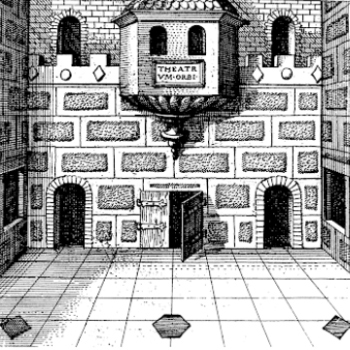 The Roman Room is just one term for the most powerful memory technique humanity has ever known.
The Roman Room is just one term for the most powerful memory technique humanity has ever known.
It helps people memorize information quickly because it allows you to “weave” mental imagery together with rooms in homes and other buildings.
We’ll get into the details on this page. In brief, using this memory technique is a very simple process where you start by taking, say, just one corner of a room in your mind.
Then, if you want to memorize a foreign language phrase or a line from a poem, you select associations that help you memorize the target information on a word by word basis.
In fact, if you get really good at it, I’ve personally seen people memorize up to 17 words by using just one corner of a room they hold in their imagination. I’ve done it myself for a recent TEDx presentation, and I’ll share details and examples from how I memorized my speech with you today.
Does the potential of memorizing an entire speech, learning a language or devouring the most important points in a textbook based on the Roman Room technique excite you?
It does?
Great! It excites me too and all the more so because this memory technique helped me learn languages and complete my PhD, not to mention learn how to use the Internet to teach, something that requires the brain to absorb literally hundreds of technical details. How could something so ancient help us in living in the modern world?
Let’s dig in and I’ll show you exactly what I mean!
https://www.youtube.com/watch?v=zz4G6...
The Origin of The Term “Roman Room”
First off, it’s important to repeat that this term is just one variation of a mental tool that appeared many thousands of years ago, long before Rome was even built. The term “Roman Room” means practically the same thing as:
Journey method
Memory Palace
Mind Palace
Memory Castle
Memory Room
Method of Loci
I’ll never forget one of my first students – he was 88 and didn’t like any of these terms. So I said call them whatever you like. He chose “apartments with compartments,” and once settled, he went on to revive his German and memorize dozens of poems.
But there’s a reason some people call this technique the “Roman Room.” This is because Roman Orators used their homes, and even the stages they spoke from, to help them memorize and recite their speeches.
In fact, a phrase we still use today is thought to come from the use of rooms as memory devices. When a speaker would say, “In the first place” or “in the second place,” this verbal habit was referring to the information in a mental room used to store the point. It’s entirely possible that the people in the audience also used the technique, and used it along with the speaker to rapidly internalize the information as they heard it.
This use of locations is why the Roman Room technique is sometimes called the Method of Loci. Loci is the plural of locus, a Latin word for a place. You have “loci” when you have strung multiple places together, such as the four corners of a room.
In the Greek tradition, we have the Story of Simonides of Ceos, which I give two powerful versions of in our detailed study of 7 Ancient Memory Palace tips.
https://www.youtube.com/watch?v=nSn2q...
Now, this technique is not just about using buildings or rooms. We also have the notion of space itself, which was incredibly special to the Greeks in many ways. As Thales said, a person widely considered to be both the first philosopher and scientist:
Μέγιστον τόπος άπαντα γαρ χωρεί
Megiston topos hapanta gar chorei
Space is the ultimate thing, as it contains all things.
Pre-historically, we have evidence that ancient people did not use rooms at all to create their memory tools. For example, people have used constellations to help them remember. Lynne Kelly demonstrates in The Memory Code how aboriginals used skyscapes both day and night to help them remember songs. She also shows how they used long stretches of geography and even objects like the lukasa to help them memorize the names and locations of medicinal plants.
I would go so far as to say that humanity has survived precisely because it learned to use external and internal structures as memory aids. Imagine trying to remember what kind of plants are safe to eat during a drought, versus which are poisonous. If you can’t remember, you’re dead.
Memory Rooms or Memory Theatres: Which Is Better For Memory Palace Training?
If you can’t find any terms you like, let’s introduce another option that I’m quite fond of and talk about Robert Fludd’s “memory theatre.” It uses rooms very specifically, or at least, that’s what memory expert Frances Yates believes. She talks a lot about Fludd’s variation on the Roman Room in her seminal book, The Art of Memory.
The idea here is that we can mentally visit locations, and this man is apparently imagining a structure like the Tower of Babel, an obelisk, what appears to be a town square and perhaps an angel introducing a new person to heaven.

On the Oculus Imaginationis diagram, we see different spaces that can be used in combination with other kinds of mental imagery to help us remember words, poems, mathematical formulas and names.
However, there is a difference to notice between ars quadrata and ars rotunda. The first is the art of using squares and the second is the art of using round and dynamic spaces, such as using trees in a forest or other shapes in nature.
As an experiment, I created my own version of The Tower of Babel and used it to memorize these two terms. On locus one, I mentally imposed a big fat circle that is badly overweight. That reminded me of the term ars rotunda. On the second locus, I imposed a square and thought of Q from James Bond bringing the secret agent into a new quadrant for ars quadrata.

Now, Fludd was apparently against using a virtual Memory Palace or any imaginary space. But that didn’t stop him from using spaces of imagination.
Who was Robert Fludd? And why should we care about his memory teaching?
He was a key thinker in the development of both scientific thinking and the use of memory techniques. He had a lively, albeit controversial exchange with Johannes Kepler, and thought deeply about the nature of the mind and memory, providing many illustrations of how he thought our mechanisms of psychology worked.
Again, it seems that Fludd preferred using actual buildings for his spatial memory work, not imaginary spaces. In fact, Yates thinks he may have used Shakespeare’s Globe Theatre for his Roman Rooms. And if you take a look at one of his diagrams, you can see that this theatre space with entrances to multiple rooms is coded in an interesting way:

Notice how the image of this theatre depicts five entrances (three on the ground floor and two on the top floor). Corresponding with these rooms are different shapes. Yates is not sure, and no one can be, but it’s easy to imagine that Fludd may have had actors stand on these shapes and then used them to walk through the rooms behind those doors.
Then, in each corner and possibly on each wall, he had pre-determined “loci” where he would place the information he wanted to memorize. We don’t know, but we can theorize that Fludd would have visited the rooms behind those doors, not imagined them. Assuming that you’re using rooms you’ve seen with your own eyes, now let’s talk about…
How To Prepare To Use A Roman Room
If you want to be a purist, you would first set a specific goal. For example, a goal might be to use this memory technique to memorize a speech, as the Roman orators would have done. But you can use this style of journey system to memorize anything else, from foreign language vocabulary and phrases to mathematical formulas.
For the vast varieties of possible memory goals and the powerful outcomes anyone who becomes a discipline of these techniques can experience, I want to correct a misconception.
It is sometimes said that memory techniques that use space are only useful for memorizing lists or what is sometimes called “unstructured” information.
This claim is not necessarily false, but it is deeply misguided about the nature of the information we want to memorize. For example, information is structured by default, isn’t it? How could it be information if it didn’t have a structure? The word information itself has multiple structures, for example.
The letter ‘I’ that begins the word is a structure, as is each letter in the word. The word has four syllables, each syllable a structure until itself. Analyzing information in this way is one of the great secrets used by memory artists to rapidly create multiple hooks and make concrete associations out of even the most concrete and abstract material. To the true mnemonist, there is in fact nothing abstract or difficult or obscure. It is all perceivable assemblages of multiple structures for which associations can always be made, if you’re trained and well-practiced.
Let’s go a bit deeper on this point:
Remember when I promised you could memorize up to a 17 word phrase in the corner of a room?
Guess what?
Every sentence is a list! It’s just one word coming after another in a particular order. We just happen to call it a “sentence.” And the word “sentence” is just a list of letters, s-e-n-t-e-n-c-e. Mind blown, or what?
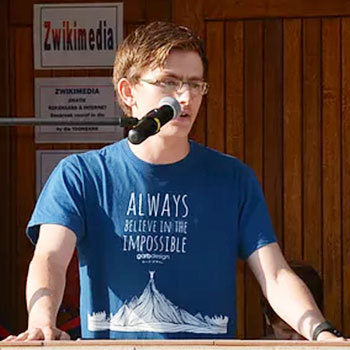
It’s the same thing with a string of digits. For example, the 1200 digits of pi memorized and recited publicly by my student Marno Hermann who established himself at the top of the South African memory competition records is technically a list, and yet…
If you use this technique properly, in a way that allows you to both get the info into long term memory and recall it out of order, you can manipulate the linear nature of information.
You can use what I call Magnetic Compounding based on ideas from Giordano Bruno that vastly explode the potential of everything memorized inside of a Roman Room.
But that would no longer technically be a Roman Room – it would be a Magnetic Memory Palace. So let’s stick with the plot, shan’t we? Here’s how to get started with your first Roman Room:
Get out a piece of paper.
Think of a room you’re familiar with.
Draw the room using just four lines to represent the room.
Represent the corners of the room with numbers.
Write down the list of the stations.

The reason I ask students to follow these steps is not just because I have loved receiving them by the thousands as symbols of people taking action. I do love that!
But I ask serious students of memory improvement to draw the Roman Room because it helps them tap into more visual and spatial memory power than imagination accomplishes on its own. We also harness the power of something called “the levels of processing effect” by physically creating this memory aid through drawing. It then becomes newly visual to you as a blueprint, which means it’s better remembered.
Then, by writing numbers and words, you’re processing it through your numerical and verbal brain – strengthening the journey. The more levels of processing, the better, and this is true no matter how good you get. I find that if I don’t complete this quick step for both simple and elaborate Memory Palaces that I create, the technique just doesn’t work nearly as well.
I think that drawing the memory journey is like the equivalent of a London cabbie driving the streets in preparation for the exam and then taking prep tests to manually write out the routes by hand. Sure, you can probably remember the routes without taking those steps… eventually. But if you really want to succeed, you’re going to do what good students do, and compound your efforts using multiple approaches.
If you’re worried that this simple Roman Room won’t be enough space to memorize much, don’t be. Here are two mindset tips to keep in mind:
If you haven’t developed the skills to memorize just four pieces of information in one room, why worry about thousands of pieces of information?
Any dedicated individual who puts in the time can pull dozens, if not hundreds of rooms from their memory.
Just think about your years in elementary school and high school. Personally, from pre-school to when I graduated with my PhD, I have drawn dozens of these powerful memory tools. And that’s not to mention all the movie theatres, cafes, restaurants, churches, hotels and bookstores I’ve seen (just to name a few possible options you surely have waiting for you in your memory).
Be willing to start small, and if you’re not willing to do that, be willing to scale back after a massive effort at making enormous Memory Palaces poses too much challenge for your spatially unexercised brain. I myself overwhelmed myself like crazy in the beginning, and it seems that some of the best students do need to feel that bit of pain in order to train themselves to simplify. There’s nothing wrong with failing to follow the advice to keep it simple, so long as you learn from the experience.
How to Use Your First Roman Room
Let’s stick with the example of giving a speech as the Roman orators did. In this case, you’ll need to write your speech first, or select one from history that you’re going to perform. “I Have A Dream,” “The Gettysburg Address” or an extract from “A Room of One’s Own” by Virginia Woolf are all fun and interesting examples you could choose from.
Then, you either want to prepare your mental associations in advance, or make them up as you go along. Both options are fine, but I prefer to complete the exercises I teach in the Magnetic Memory Method Masterclass so I don’t have to waste time inventing the imagery. I always have associations popping up without any effort at all.

Next, start on the first locus of your new Roman Room.
Let’s use my February 2020 TEDx presentation as an example.
The first line was:
“How would you like to completely silence your mind?”
To memorize this line, I simply started at the first locus and thought of Howie Mandel.
Why this comedian?
Well, besides the fact that we’re both Canadian and I liked him a lot when I was a kid, “how” and “Howie” have the same letters and basic sound.
I then imagined him chopping wood (would) while hitting thumbs up on his phone (like). Once this part of the line was encoded, I didn’t need the rest of the line because this was the point of the talk.
However, if I had needed imagery for it, I might have used a swan because swans look somewhat like the number 2. For silence, I might have heard the Christmas carol, “Silent Night.” For “your mind,” I might have thought about Howie breaking the Ministry album, “The Mind Is A Terrible Thing To Taste” over his knee.
From there, I just carried on to the next locus in the Roman Rooms and encoded the next line. Sometimes I needed to encode the sentences word for word, but other times I only encoded keywords. It’s a fairly long talk, but I can often get a lot of words on one locus, so it took the equivalent of 8 Roman Rooms in total.
But again, “Roman Room” is just one of many possible names for this technique, so it’s important to not focus on the terminology, but rather understand that the Magnetic Memory Method has fused all of the best techniques together into one smooth and systematic approach.
Practicing the Roman Room Technique For Long Term Memory
This is the fun part of using the Roman Room method.
You see, encoding is only half of the task. You also have to practice decoding the speech.
To do that, I followed a few unusual steps that I recommend to anyone using this technique.
Recall the speech forwards from beginning to end.
Pick segments of the speech to practice in different orders.
Walk the Roman Room while reciting.
Reciting the speech from beginning to end is obvious. That’s how you want to deliver it, after all.
But if you want to be absolutely flawless and have no hesitations, each part needs to really stick in your mind. If you only practice starting from the beginning, you will give the beginning what is called Primacy Effect. The end will get what is called Recency Effect.
These laws of memory, first identified by Hermann Ebbinghaus in his book, Über das Gedächtnis (about memory) show that we tend to remember best the first and last things we encounter in an information series.
You probably have heard a friend who can tell you how a movie begins and ends, but completely botches retelling the middle of the story. This happens precisely because of these effects.
To avoid that problem while standing in front of the audience, I recited my speech out of order so that each part received sufficient doses of primacy and recency.
Basically, I followed a number of patterns that I share in my free Memory Kit available at magneticmemorymethod.com/yt. The course includes detailed worksheets, a homework assignment and many more valuable tips for improving your memory with the most powerful techniques we as humans can learn and use.
These Recall Rehearsal patterns are very powerful, and because all information is structured, there are even more I know and followed, including jumping in at random to recite only the quotes I had included in my speech.
I spoke entirely from memory, using no slides or pictures. I had to nail each and every quote, and I did thanks to the fact that each was robustly remembered. Using these patterns to practice recall is the best way to achieve that level of bulletproof delivery and remove all nervousness. For more information:
Pegword Lists and the Hook Method
One neat way you can get more out of this technique is to learn how to use the pegword method, which is sometimes called the “hook method.”
In some sense, I’m already doing this in the example I just gave. Howie Mandel became a kind of hook that carried my memory across several words.
However, if you develop a set of images for each letter of the alphabet, you can link your Roman Rooms to each letter.
For example, locus one can be the A-locus. Perhaps you have a friend named Alan or Albert who will always be standing there.
Then, if you want to memorize a line like the one from my speech, you could see him fistfighting with Howie Mandel (or some other Howard). This can be useful for beginners because sometimes it can be a struggle when you’re new to think of what images you used. But if you know what each letter stands for, then it’s easier to remember that it was Alan punching Howie to kick-off a sentence that starts with “how” because you know Alan. Howie is just an actor on a screen who has not been able to activate nearly as much of your brain and memory.
I have a detailed example list of images that I’ve used on my tutorial about the pegword method.
How to Expand Your Roman Rooms
As mentioned, you can easily create more Roman Rooms. Most people have potentially thousands of them in their minds.
But let’s say you want to make one bigger.
Let’s look back at the Robert Fludd theater again.
You can do the exact same thing as Yates imagines Fludd did.
Let’s say that in Roman Room #1 you include 5 doors. Personally, I would encode these alphabetically.
Behind door A would be the entrance to my friend Alan’s home office. (I actually use his entire house, but just one additional room does a lot to expand into more space if you’re not ready for bigger Memory Palaces.)
Behind door B would be my dad’s workshop (his name starts with B). Behind door C, I might use one of my highschool sweetheart’s homes… sigh, Ah Charla, whatever happened to you?
Another way you can expand any Roman Room is to add the walls. Four corners and four walls = 8 loci. You could also add the floor and ceiling, giving 10. This configuration is the so-called Vaughn Cube.
Or, you can change the color or your first Roman Room and reuse it. This is very mentally taxing, which is why I discourage beginners from using the technique in The Definitive Guide to Reusing A Memory Palace.
Finally, you don’t have to stick to the corners and walls. This practice is my personal preference now because I memorize a lot of verbatim lines. But for language learning, I like to add furniture. Sometimes multiple shelves of books can be useful too, but generally the more compressed the space, the more difficult it can be to manage.
How to Modify A Roman Room
As I discussed in my writing on How to Renovate a Memory Palace, I generally discourage making changes after-the-fact. It’s time consuming and reveals that you haven’t really put enough time into planning either your Roman Rooms or your learning goal.
For example, it would have been a huge frustration and a waste of time if the rooms I used for my TEDx needed to be changed along the way.
Not only that, failing to structure the journey correctly from the beginning could have led to completely blowing the talk altogether.
If you really must modify a room after-the-fact, I suggest that you do it after all the core information has already been entered. Then, see if you can add a wall where you previously only used the corners. Or use the foot of the bed where you previously used only the pillow area.
When you get really good at this technique, you’ll find that you can get extremely detailed in your Memory Palaces. Mary Carruthers tells us in The Medieval Craft of Memory that John of Metz used every stone of the tower he lived in for his loci. He must have practiced a lot to reach that level of skill!
Is This The Best Memory Technique?
Success with any memory technique you choose depends on your goal. It also depends on your current level of skill and on the nature of the information. This is as true of Roman Room memory solutions as it is of every mnemonic technique you’ll ever find.
At the end of the day, preparation matters. I suggest that beginners start with simple goals, like a handful of vocabulary in a foreign language or song lyrics.
To learn an entire language, you’re going to want to develop at least one Memory Palace Network.
If you want to deal with numbers, you’ll need to add a second technique, either the Major System or the Dominic System – both are essentially pegword methods tailored for numbers. And rest assured that they’re not new. They both descend from the Katapayadi system which we can track back to 683 CE.
There’s so much more to be said about all the memory systems out there. But the best thing to do is pick one, get started and stick with it for at least 90 days. Practice a minimum of 4x a week. No matter what approach you use, it’s consistent study and practice that we each need to become memory masters.
May 21, 2020
The Victorious Mind Audiobook: New Memory Improvement Book Sampler
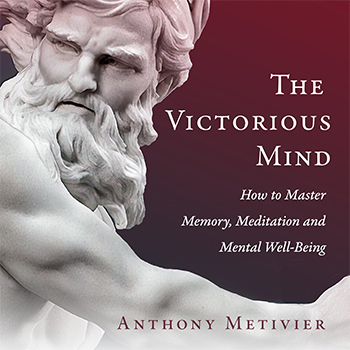 Is it really possible to stop mental torment?
Is it really possible to stop mental torment?
Can the human mind actually completely stop thinking?
These were the questions on my mind when I started the memory and meditation training that culminated in The Victorious Mind: How to Master Memory, Meditation and Mental Well-Being.
In today’s episode of The Magnetic Memory Method Podcast, I’m sharing the opening of the audiobook version of my latest book.
Trigger Warning: It’s gritty.
But for those unfortunate enough to suffer from scattered thinking and endless torrents of negative thoughts, I’m confident this book will help you make a positive change.
About The Victorious Mind
The Victorious Mind tells the story of how one man – film scholar and creator of the Magnetic Memory Method Anthony Metivier – overcame the mental distress that imprisoned him in a “highly functioning manic-depressive” identity, and almost took his life, using three practices: self-inquiry meditation, memory training, and “biohacking.”
But more than a story of self-transformation, the book offers detailed guidance through the techniques Anthony used to release himself from the haze of lithium along with the illusion of self. Both entertaining and erudite, brain-science informed and stripped of BS, The Victorious Mind takes us along on a journey through cities of the world and Memory Palaces of the mind, where there are bad acid trips along the way but also Buddha Smiles.
The Victorious Mind is peopled with a surprising range of figures, from members of his Magnetic Memory Method community and Ancient Greek mnemonists, to secular-spiritual teachers of today such as Gary Weber, whose translations of ancient Sanskrit self-inquiry texts play a central role in Anthony’s self-transformation.
This book is ideal not just for those struggling with mental illness but for anyone suffering mental malaise – whether it’s digital amnesia and scatterbrain, depression or “control freakism.” What sets this book apart is also what defines its key message: there’s no one technique, no one path to freedom and quality of mental and physical life, and there’s no one teacher.
Rather, it’s the act of assembling the insights and practices of others with experimentation in one’s own body and mind that will enable us to be our own teachers, bring peace of mind and focus, and free ourselves from negative thinking.
https://www.youtube.com/watch?v=ox4Ay...
Praise for The Victorious Mind
If only The Victorious Mind had been written ten years ago… It would have saved me a lot of frustration and self-blame in failing to keep up my regular meditation practice. Now I not only know why I struggled so much, but what to do instead.
– Seph Fontane Pennock, Co-founder, PositivePsychology.com
In The Victorious Mind, Anthony Metivier brings his terrifying experience of mental illness together with his depth of knowledge of memory systems to show how using mnemonics systematically can ease a troubled mind and replace terror with joy. This is a unique book from an author who speaks from a lifetime of experience beyond anything I could have imagined.
– Lynne Kelly, author of The Memory Code and Memory Craft
Anthony Metivier has a compelling personal story and a remarkable, practical methodology of helping us move beyond our stories and into the living truth. With one foot planted firmly in the relative and the other rooted in the Absolute, Anthony has hit the sweet spot that combines the two – which is authentic nonduality.
– Fred Davis, author of Awaken Now and The Book of Undoing
With so many memory books out there, this is really the first I’ve ever seen that heavily intertwines the ideas of meditation and memory. I’ve always felt the two go hand in hand and Anthony really does an amazing job at showing that! I highly recommend this book!
– Nelson Dellis, 4x USA Memory Champion and author of Remember It!
The Victorious Mind is a masterful book written by a master of the field. Anthony Metivier has written an invaluable resource to anyone who wants to learn to fully utilize their cognitive capabilities to build a sharper mind and a better life.
– Nir Eyal, bestselling author of Hooked and Indistractable
At last, someone has remembered the true purpose and potential of the Art of Memory. In times past, it was seen as a path of self development. Using its methods you could bring health, harmony and excellence into your mind and thus your life. Sadly, this beautiful, beneficial art has been all but forgotten, until now. In this dynamic book, Anthony Metivier teaches you this ancient wisdom with a modern slant. Written from his own experience this is a book that will show you how to develop a “magnetic” memory that holds the information you wish but also attracts the influences you want into your life.
– Martin Faulks, author of Enlightened Living
Anthony Metivier is a Warrior of the Mind!
– Tony Buzan, author of Mind Map Mastery and Co-Founder of the World Memory Championships
Dr. Metivier is a master of his craft and experienced teacher of the bridge between memory and meditation. In The Victorious Mind, you’re learning from the best!
– Jonathan Levi, author of The Only Skill that Matters and creator of SuperLearner
I now remember whole chunks of passages in another language. I’m learning with such ease that I often think it can’t be this easy. The real “work” has been to calm my anxieties, and in this, Anthony is a very wise and effective guide and teacher. I am very grateful to him.
– Jeannie Koh
I am usually a bit of an anxious person – not always suffering, but just someone with a very chatty mind, I’m always thinking, and being able to direct this energy in a productive way is very appealing to me. You have helped me direct my anxiety better.
– Daniella Lopez
I have made a lot of progress using this meditation technique to improve my spatial awareness and to see things clearer!
– Jeff Jansson
Anthony’s writing always triggers major moments of insight. The Victorious Mind goes deep and far beyond your typical “3 step method.” Highly recommended.
– Jimmy Naraine, motivational speaker
I’ve witnessed first-hand Anthony’s ability to channel his mind into overcoming challenges that would destroy most people. Extraordinary and inspiring.
– Olly Richards, iwillteachyoualanguage.com
The Victorious Mind is unlike any book I’ve ever read about memory and the human mind. Anthony shares his personal experiences with mental health, advanced memory practices and various types of meditation. He uses engaging personal transformation stories that stayed with me long after I read the book. It’s meticulously researched and contains many practices I’d never tried. I’m already working on my vision statement.
– Bryan Collins, Becomeawritertoday.com
Anthony has spent a lifetime bringing useful information to light on the subject of memory. In his latest work, The Victorious Mind, he opens an amazing door into the world of the human mind, blending ancient memory techniques with captivating meditative experiences. If you want a personal adventure into peace of mind, this is the read for you.
– Jim Samuels, author of Re-mind Yourself: Better Memory, Lower Stress
In one word… Wow! In this highly engaging and worthwhile book, Anthony shares his personal story… sometimes some very raw and vulnerable moments. I have completed masters studies in neuroscience and thought I knew a fair bit about memory. I even believed my memory capacity was reasonably good. I wasn’t even close! After reading The Victorious Mind, I realised there is so much more to embedding and remembering information successfully, which makes our lives more fulfilling.
– Josie Thomson, MCC and author of The Wise Advocate: The Inner Voice of Strategic Leadership (with Jeffrey M. Schwartz and Art Kleiner)
I’ve never read a memory book so visceral, yet so practical. Anthony holds nothing back in The Victorious Mind as he tells of his life-long struggle with mental illness in a manner both touching and humorous. I even learned things that I look forward to applying in my own memory training! I can’t recommend this book enough for anyone out there looking to improve their mental fitness.
– Braden Adams, 2x Canadian Mind Sports Association National Memory Champion
I consider Anthony Metivier a personal mentor. If there is someone who thinks about and uses memory techniques as often as he does, I haven’t found that person. He connects the dots better than anyone I know and will teach you how to use mnemonics to enhance the quality of your life.
– John Graham, 2018 USA Memory Champion
As a neuroscientist, I study the underlying mechanism of memory techniques and I am very interested in their widespread application. Because Anthony is such an expert in this field, having him uncover the use of mnemonics for mental health is fantastic and will help many readers!
– Boris Konrad, Guinness Record Holder and Memory Competitor, Award-Winning Speaker, and Neuroscientist
As a life long student of the art memory, I’ve read my fair share of rehashed How to memory books; this is not one of them. As someone who has dealt with depression and anxiety since leaving the military, this book really hit home. Dr. Metivier takes you through a guided tour of his early life, the demons he faced, his process of overcoming them, and his journey in becoming the modern-day Giordano Bruno.
I can not thank him enough for his part in my metamorphosis from a mentally beat up U.S. Vet to a top student in University.
– Adolfo Artigas
I bought this book in hopes for some memory techniques and a good read. Instead, I was surprised to behold a Swiss Army knife of meditation, breathing, and memory skills wrapped in the warm blanket of human experience and fascinating autobiography.
The writing is concise and to the point. Necessary for the teaching of time honored techniques and exercises, put here to a new focus. Memory and well being. Anthony reveals great vulnerability in telling his story through the sufferings and mishaps that plagued his past, but there is no , “poor me” syndrome in the tone of his writing. He writes sincerely, with an open heart, to help others avoid the detrimental mental states that limited his potential during his obvious suffering.
He encourages you, step by step, leading you in exercises to avoid/alleviate the pitfalls he encountered. Inspired by the traditions of Zen Buddhism, Mindfulness, and the works of Gary Weber and Alan Watts, Anthony Metivier brings you lifetimes of meditation practices without you having to sit under a tree for eternity or stare at a wall for millennia.
Where he really shines is in the memory exercises which are his expertise! Whether you have been using Memory Palaces for decades or are following along building your very first palace, he guides you thoughtfully into the powerful techniques which can transform your life. I found his candid tales through dangerous mental states inspiring and egoless. He did not make this book to huff and puff about highfalutin memory techniques. He draws you through his suffering and allows you to experience the grace of success within the handling of his own mental state with the exercises he bequeaths to you in this charming book. Come for the techniques, stay for the drama! You will not be disappointed.
– Christian Fitzharris
How to Get The Victorious Mind
The Victorious Mind on Audible
May 13, 2020
John Fotheringham On Crafting Better Mental Tools For Language Mastery
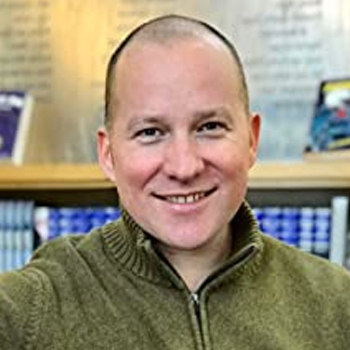 Ever really stopped and thought about how language learning occurs?
Ever really stopped and thought about how language learning occurs?
When you’re a child the majority of the way learning occurs is listening and speaking, right? But what about when you progress in school and you are taught a second language as part of your curriculum? Is it the same process?
Or is the focus more on reading and writing?
Listening and speaking are innate, they’re organic, and it seems like they just happen “naturally” after much “natural” coaxing from parents and other people in the environment.
Or are they…?
Normally, we might say that reading and writing are human technology, an invention that differs from language itself. But learning these tools of representation language visually also involves a lot of coaxing and they are not any more or less invented than language. And when it comes to writing, it’s just a fact that some people go to school for decades, earn PhDs and still can’t write their way out of a cardboard box.
I know this from personal experience because I’m still struggling to de-academize my own writing after all those years of indoctrination!
April 29, 2020
What is Mind Mapping? The Ultimate Guide to Using This Powerful Tool
 Do you ever wonder, “what is mind mapping” exactly?
Do you ever wonder, “what is mind mapping” exactly?
Well, imagine you’re listening to a history lecture. Instead of taking notes, your fingers itch to make a mindmap of World War I events as you hear them.
But how do you draw mind maps?
And, can mind maps alone boost your memory, learning power, and creativity?
In this article, you’ll explore a complete guide to mind mapping, how to draw one, including multiple examples of mind maps. We’ll also examine whether mind mapping alone can improve your brainpower and creativity, and what else you can do.
Here’s what I’ll cover:
What is Mind Mapping?
Benefits of Mind Mapping
Who, When, and How to Make a Mind Map
Tools You Can Use for Mind Mapping
Can Mind Mapping Alone Improve Your Memory?
How to Combine a Mind Map with the Major System
What is Mind Mapping?
Mind mapping is a simple, visual way to organize your ideas for better clarity and recall. Mind maps focus on only one central concept or idea and are based on radial hierarchies and tree structures.
What does all that mean? Let’s get into the details.
A Brief History and Definition of Mind Mapping
The practice of drawing radial maps to map information goes back several centuries.
Some people credit the first mind maps to the 3rd-century philosopher Porphyry of Tyros. Ramon Llull, Leonardo Da Vinci, and Isaac Newton also used mind mapping techniques. Much later, in the 1960s, scientists Allan Collins and Ross Quillian developed the semantic network into mind maps.
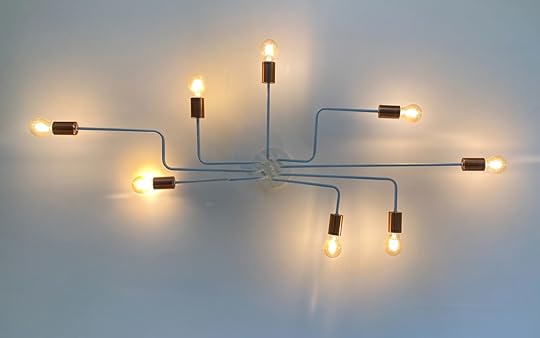
However, it was psychology consultant Tony Buzan who first popularized the term “mind map.” Buzan drew colorful, tree-like structures called radial trees where a central topic branched out to several sub-topics.
The Tony Buzan Learning Center defines their Mind Map® as “a powerful graphic technique which provides a universal key to unlock the potential of the brain. It harnesses the full range of cortical skills – word, image, number, logic, rhythm, color, and spatial awareness – in a single, uniquely powerful manner.”
These pictorial representations introduced by Buzan are now being used by students, teachers, engineers, psychologists, and others in many ways.
So, what does a mind map look like?
Examples of Mind Maps
A mind-mapping exercise is colorful and engaging. And, the result looks analytical and artistic at the same time.
Here are some great examples of how fun and engaging mind maps can be. Some of them look messy — but look deeper and you’ll see they are examples of detailed trains of thought.
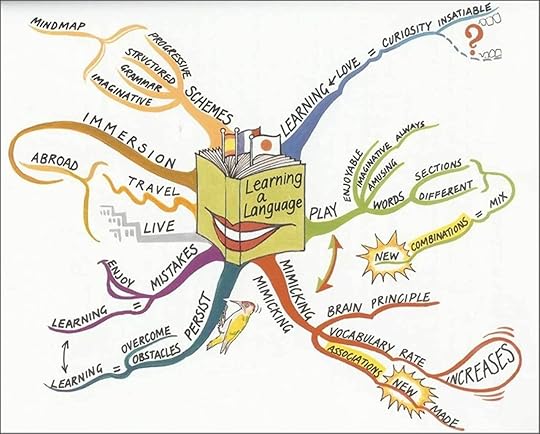
Source: Tony Buzan Learning Center
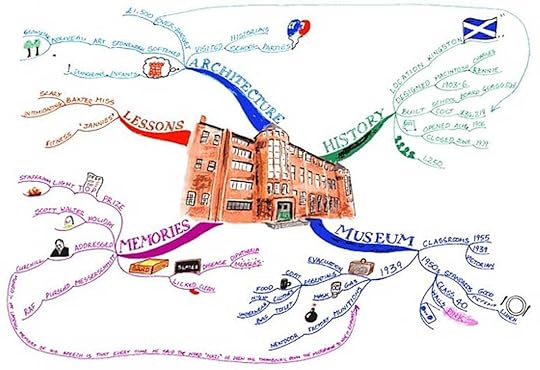
Source: MindMapArt
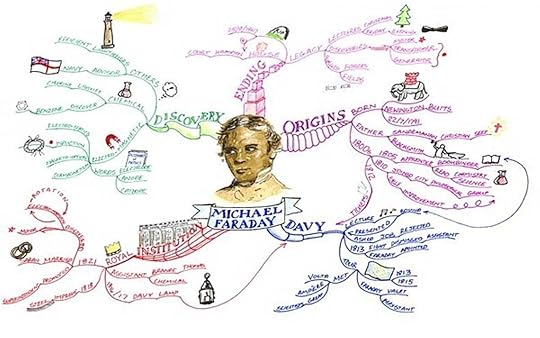
Source: MindMapArt

Source: BiggerPlate
These fascinating examples are colorful, though in some cases, also quite visually overwhelming.
That’s why I’ve pared down my own style, and am glad I got Tony Buzan’s seal of approval after doing so:
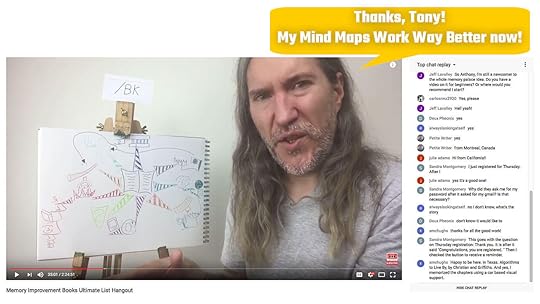
Anthony Metivier with a Buzan-style Mind Map
But you might be asking: aren’t these the same as spider maps, concept maps, and other such visualizations?
No. There are some key differences.
How is Mind Mapping Different from Other Visualizations?
A mind map represents the natural way you think — quite unlike linear note-taking.
Let’s look at some similar visualizations:
Concept Map: Concept mapping connects multiple ideas. These maps have text labels on the connecting lines based on connections between each concept.
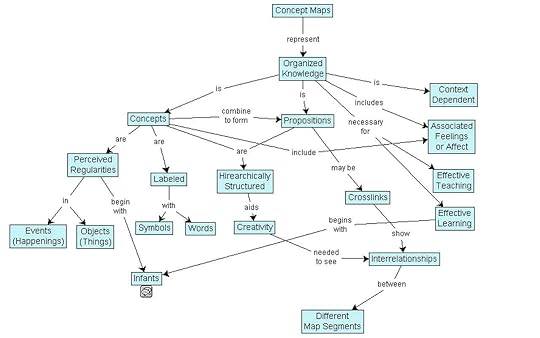
Source: Wikipedia
Graph Data Modelling: This model is a semantic network made up of nodes and relationships between entities.

Source: Neo4j
Graph data modeling is created using words and icons, but with a focus on end-users’ needs. Mind maps serve a different purpose: helping improve your memory and organization.
Spider Diagram: Both a mind map and a spider diagram start with a central idea. But mind maps have main ideas and sub-ideas, while a spider diagram has nodes from each hierarchical line.
See the diagram below:

Source: LucidChart
However, none of these techniques count as mind maps because they don’t mimic the natural way your thoughts flow.
Is visual note making more effective? Let’s find out.
Why are Mind Maps Effective?
Nobel prize winner Dr. Roger Sperry’s research proved that visual forms of note making are more effective than written methods.
He showed that the brain is divided into two hemispheres that perform cortical skills like logic, imagination, color recognition, and others. These functions work in sync when you mindmap your thoughts, creating a lasting impression in your brain.
Mind maps are effective because:
They nudge you to ditch the usual, bullet-point style of thinking, which pushes you to use your creativity.
They are presented in a brain-friendly format — and people can grasp the linkages quickly.
They let you see the bigger picture.
They keep you focused on key issues.
They give you time for “diffuse thinking” as you pause to change colors and reflect on keywords and images.
And, they help you retain and recall more information through patterns and associations.
Next, let’s look at why mind mapping can be beneficial.
Benefits of Mind Mapping
Years of research have gone into testing the effectiveness of mind mapping.

In a 2005 study by G. Cunningham, 80% of the students agreed that mind mapping helped them understand science concepts better.
Paul Farrand proved the efficacy of mind mapping as a study technique and encouraged its use in medical curricula.
Mind maps are known to help you to improve your productivity at work, academic success, and even to manage your life.
Here’s how you could apply it in your day-to-day life:
Note Taking: You can map out notes from a podcast, a project discussion, or a seminar.
Brainstorming: Helps in real-time collaboration with your team members to make informed business decisions.
Studying: You can summarize books.
Presenting information to an audience: Use it to get your team’s buy-in for anything through clear narratives.
Problem-solving: Sometimes, it helps if you map out your current situation and your desired situation separately. This will help you come up with solutions easily.
Increasing creativity: The words, images, and colors you use let you see the information from a very different perspective.
Planning: Plan your holiday or your next sales strategy using mind maps.
Language learning: Use a simple, 12-point mind map to combine 12 vocabulary words with the Major System. Here’s how:
Who, When, and How to Make a Mind Map
Now that you have a fair idea of mind maps, let’s understand who should use it, as well as when and how.
Who Should Use Mind Maps?
Mind maps are particularly helpful for those who:
Remember a visual image or a diagram better than written pieces.
(Or need practice becoming more visual.
Deal with lots of information or a project that needs more clarity.
Need to brainstorm for ideas from others to build a bigger project or solution.
Mind mapping has also proven useful for dyslexic students and those with ADHD.
When Should You Use Mind Maps?
Create mind maps when you need to achieve some goal — to understand your course material or project better, or to assess the ideas from brainstorming sessions.
Remember — mind mapping isn’t the end goal by itself.

And don’t spend too much time perfecting it. If it takes too long, it may hamper your creative thinking.
How to Make a Mind Map
Drawing a mind map is pretty straightforward.
For example, if you want to prepare a meeting agenda take a blank page and follow these basic steps:
Draw a bubble in the middle of the page with the title of your meeting.
Branch out with new bubbles from the central theme, with each branch representing the topics you want to address.
Draw lines to connect each of them to the middle bubble.
Add new ideas starting from the general to the specific.
Repeat this for each subtopic branching out from the topics.
What are the Rules for Mind Mapping?
Mind maps are meant to be hierarchical and show relationships among pieces of the whole.
What are the guidelines you can use?
Tips for Drawing a Mind Map
Here are some mind mapping rules to make your mind map project expressive and compelling.
Use colors, illustrations, and pictures: Some of the most effective mind maps have more doodles and symbols than words.
Keep the topics and sub-topics brief: Stick to a single word each, or just a picture instead of long phrases or sentences.
Keyword for branches: Name your branches or lines using a keyword each.
Use different text sizes and alignment: Provide as many visual cues as you can to emphasize important points.
Use symbols: Draw symbols like arrows and shapes to classify your thoughts.
Space it out: Leave enough negative space between your idea bubbles.
Highlight important stuff: Highlight important branches or bubbles with borders or colors.
Create linear lists: You can create linear hierarchies using bullet points and numbered lists.
Mix up word sizes and fonts: Add in hierarchies of words using different font sizes to highlight their importance.
Use varying cases: Use lower and upper cases to highlight the importance of ideas.
Every little effort you put into your mind map project will engage your brain. And, all these visual aids will make your mind map more memorable and easier to recall.
Now, do you draw mind maps on paper, or is there a diagramming tool to do it?
Tools You Can Use for Mind Mapping
You can draw mind maps by hand, just like note-taking during a lecture.
Or you can use websites or mobile phone apps to do it.
Traditional Mind Maps
Nothing is as comforting as putting pen to paper when an idea strikes you. This is, in fact, the simplest way to map your ideas.

It is your personal project — your thoughts, handwriting, and your doodles. You can create it yourself or in groups on a whiteboard during a brainstorming session.
The pen-and-paper method works perfectly most of the time, but it does have limitations:
You may not have enough space on the paper to expand your thoughts.
You can’t make too many corrections.
And, it may not always be presentable enough to share in a formal meeting.
The other option is to use mind mapping software — websites and apps.
Mind Mapping Software
Mind mapping apps and websites help you organize your ideas and store large amounts of data in a single location.
What makes for great mind mapping software?
The best mind mapping tools…
Allow you to create a wide network of ideas, facts, and connections.
Let you make quick changes through automatic spatial organization and hierarchical structuring (particularly useful while brainstorming).
Let you play with fonts and colors, and even drag and drop files into the mind mapping program.
Which are the Best Mind Mapping Software Tools?
Here are three of the best online mind mapping tools available today:
1. MindManager by MindJet: This tool is for business users — a professional mind map maker with MS Office integration. You could even pick a mind map template in the tool to get started.

Source: MindManager
2. XMind: This mind mapping tool has a simple interface and is mainly for enterprise-level users. It lets you convert your mind maps to a Gantt chart that shows the start and end dates and progress of each task.
You can even use a countdown timer to time your sessions on this mind mapping software (this will keep you focused and will stop you from spending too much time mind mapping and brainstorming).
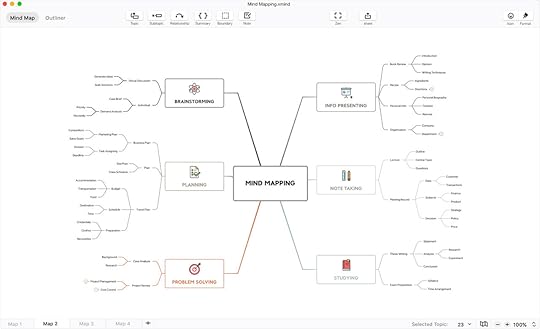
Source: XMind
3. Scapple: This mind mapping tool was built for writers by a writers group called “Literature and Latte.” It is easy to use and comes with great features (minus embedding audio and video).
With this mind mapping application, you’re not limited to starting with a central theme. You can begin with a small idea, then work backward to reach the main idea.
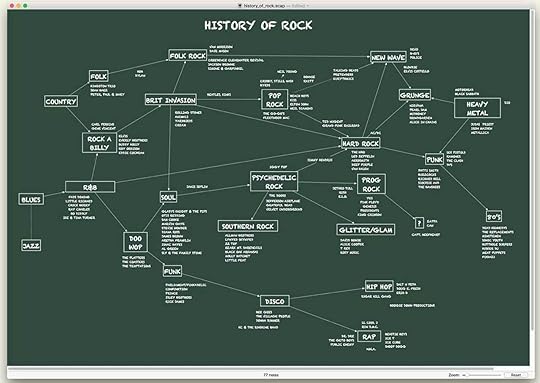
Source: Scapple
You could also experiment with an open-source free mind mapping tool like FreeMind or Coggle.
The point is this: there are a lot of options. For an example of one teacher who uses software and teaches with a specific focus on personal develop is Joseph Rodrigues. Here’s one of his best:
Software options aside, now for the big question:
Can Mind Mapping Alone Improve Your Memory?
Mind mapping can improve your memory to a good extent because it involves association and imagination.

Words, images, colors, and branches create mental focus and energy and help you to place information into memory.
But, the best part is, you can multiply the power of mind maps by using Memory Palaces and the Major System.
Curious to know how?
Read on.
How Mind Maps Help You Find More Memory Palaces
You can use mind mapping to find multiple homes for memory palaces.
Create a mind map for all the homes you know — your apartment, your school, office, the coffee shop. Jot down all specific details inside them.
This way, you make better associations that lead to more familiar places for multiple potential Memory Palaces!
Then quickly use these new Memory Palaces to store any information you want to in your memory. These Memory Palace books will help you learn more if you’re confused about how to use this tool.
Revisit the imagery several times (the Magnetic Memory Method Recall Rehearsal) to commit it to your long-term memory and recall it whenever you need to.
How to Combine Mind Maps with the Major System
The Major Method works by associating numbers with sounds where each number is connected with a consonant. For example, 1 = d, t, 2 = n, 3 = m, and so on.

Imagine that your page is a clock with 12 branches. Create your central image and radiate your branches from it starting at 12 o’clock.
Going by the major system, mentally impose or draw TN (or “Tin Tin”) at 12 o’clock.
After you create the branch, think about how your keyword can interact with “Tin Tin.” If your keyword is “Shakespeare” and sub-branches are Romeo and Achilles, you can think of them in a car chase with Tin Tin.
You can use all the magnetic modes to “magnetize” them into your memory. This includes the spatial magnetic mode – the memory palace – which in this case is the mind map itself!
Mind Map + Memory Palace = Magnetic Memory
A mind map is an excellent non-linear visual representation of your ideas that mimics the way your brain thinks.
Once you master it (whether you use a notebook or a mind mapping software), you’ll never go back to linear note-taking ever again. But, mind mapping alone may not boost your brainpower as much as when combined with the Magnetic Memory Method. If you need more mind map examples, we have plenty.
Ready to use this combination to fire up your memory, creativity, and learning? Sign up for my free memory improvement kit today!
The post What is Mind Mapping? The Ultimate Guide to Using This Powerful Tool appeared first on Magnetic Memory Method - How to Memorize With A Memory Palace.
April 14, 2020
Memory Palace Books: Top 5 Resources to Supercharge Your Brain
 Are you looking for the best Memory Palace book to help you keep your memory razor-sharp?
Are you looking for the best Memory Palace book to help you keep your memory razor-sharp?
Ask any search engine, and it will throw up plenty of memory improvement book recommendations with techniques that may or may not work for you.
Which one do you choose?
And, could there be any alternative ways to train your brain to remember and recall everything you want to?
In this article, I’ll give you five Memory Palace book recommendations to make your search easier. I’ll also show you three alternative ways to sharpen your brain.
Here’s what I’ll cover:
5 Best Books to Learn Memory Techniques and Improve Your Memory
3 Better Ways to Improve Your Memory
5 Best Books to Learn Memory Techniques and Improve Your Memory
Several authors – including Mira Bartok, Dominic O’Brien, and Joshua Foer – have dived deep into the concept of Memory Palaces.
Here’s my pick of 5 excellent books on memory improvement for you to read. A compilation of these could create a treasure trove of memory improvement ideas, including the art of building memory palaces.
Let’s get right to it with my first recommendation.
1. Moonwalking with Einstein: The Art and Science of Remembering Everything by Joshua Foer
First published in 2011, Joshua Foer’s bestseller debuted at No. 3 on the New York Times bestseller list and stayed on the list for eight weeks.

In his engaging writing style, Foer will take you on a fascinating journey through how the mind of a memory champion works. He goes in-depth about the mnemonic techniques they use to store memories.
A freelance science journalist, Foer learned the technique of memory training while researching the US Memory Championship. At the contest, Foer observed how people would memorize an entire deck of cards in just a couple of minutes.
This fascinated him and got him thinking whether the skill could be learned. Foer discovered that individuals who aced memory contests used special strategies handed down from the ancient Greeks to visualize things.
Most people use Memory Palaces by visualizing a structure (such as their home) in their mind — these Memory Palaces usually have several different rooms and people inside who represent what they are trying to remember.
He decided to test his own memory power.
A year later, he won the US Memory Championships against champion ‘mental athletes’ who could memorize the exact order of ten shuffled decks of cards in less than an hour.
The book draws on thorough research, the history of memory studies, and various tricks of mental champions.
2. The Art of Memory by Frances A. Yates
Published in 1966, this book is still referenced in influential memorization guides and books today.

The author, France A. Yates, traces the development of the mnemonic systems from the Simonides of Ceos era through the Renaissance until the 17th century when scientific methods were initiated.
This is the oldest mnemonic strategy and is also known as the method of loci.
The book narrates the story of Simonides, who was hired by a nobleman to read poems during a banquet. After the reading, he was asked to go outside to meet someone. Before he could re-enter the banquet hall, it collapsed, killing everyone inside.
All the bodies were mangled beyond recognition. The story goes that Simonides used his memory to recall the faces and names of every person that was killed. He realized the importance of recalling facts based on their locations or the method of loci.
These ideas hold good even now.
For example, if a defense lawyer needs to recall evidence during a trial, he can first create mental images of a place familiar to him – maybe his home – and peg each piece of evidence to a room. During the trial, he can then recall those pieces of evidence by mentally walking through his house.
But there’s more to it than memory stunts for winning court cases. Witness…
3. The Memory Palace of Matteo Ricci by Jonathan Spence
In this book, the author explores the story of a Jesuit priest named Matteo Ricci who lived during the 16th century, and how he used special mnemonic memory techniques to convert the Chinese to Christianity.
 The priest joined the new Catholic order, the Society of Jesus, in 1571 and studied law in Rome. At that time, the order was quite young and needed to widen its influence. To ensure this, it would send young priests into the world to convert people to Catholicism.
The priest joined the new Catholic order, the Society of Jesus, in 1571 and studied law in Rome. At that time, the order was quite young and needed to widen its influence. To ensure this, it would send young priests into the world to convert people to Catholicism.
The story goes that Ricci became a willing member of that mission and sailed to China as a missionary. For more than three decades, he used his vibrant personality to convert the Chinese to Catholicism. I imagine he knew a lot about how to memorize speeches.
During his efforts, the Jesuit priest believed he could convert more people by impressing them with his learning. That was when he started to use mnemonic devices to memorize huge amounts of information.
One of his key tasks was to convey basic Christian principles to the Chinese people in a manner they could appreciate and learn from. So he turned to memorization techniques for help.
He taught the Chinese people the art of creating memory palaces through images in their heads, helping them store several pieces of information in their mind and be able to recall it later.
The images acted as a narrative or a story helping the Chinese understand the Bible and its teachings through their own cultural and spiritual norms.
4. How to Remember Anything by Mark Channon

In this book, memory grandmaster and author Mark Channon focuses on how a radically improved memory can add more value to anyone’s personal and professional life.
It is filled with memorization techniques that teach you how to recall numbers, dates, and facts, as well as ideas on how to remember them by using different processing strategies.
This makes the book one of the most practical ones on the art of memory improvement.
It comes with innovative exercises that can build the confidence and vocabulary of readers. It also includes core strategies that can make memories and mental images more ‘magnetic’.
5. Unlock Your Amazing Memory: The Fun Guide That Shows Grades 5 to 8 How to Remember Better and Make School Easier by Brad Zupp
If your children are struggling with learning in school, this book has plenty of ideas you could use.
 It outlines powerful strategies that can improve memorization skills while making it a fun activity. The techniques teach them to remember what they see, read, and hear – three traits that can result in better grades and more confidence in classroom settings.
It outlines powerful strategies that can improve memorization skills while making it a fun activity. The techniques teach them to remember what they see, read, and hear – three traits that can result in better grades and more confidence in classroom settings.
These strategies are scientifically proven and claim to have helped thousands of students — those who want to improve their grades, who are forgetful, lack motivation, prefer some subjects over others, feel stressed out or bored in class, and those who have a hard time completing their homework on time.
The book is based on The Feats of Memory show which is an assembly program that was created by the author, Brad Zupp himself. Teachers who have used his techniques say that it transformed the way their students processed their lessons and made tremendous improvements.
The guide also dives into the main issues that affect our attention spans – our memory and focus. This makes it especially useful for students in grades 5 to 8. Children in grades 3 and 4 can also benefit from it with some help from parents and teachers.
6. Bonus! The Victorious Mind: How To Master Memory, Meditation and Mental Well-Being by Anthony Metivier
So maybe it’s cheating a little bit to include your own book, but if you’re looking for the best books to help you learn memory techniques it’s one I highly recommend!
 The Victorious Mind tells the story of how I overcame the mental distress that imprisoned me in a “highly functioning manic-depressive” identity and almost took my life. I used just three practices to do so: self-inquiry meditation, memory training, and “biohacking.”
The Victorious Mind tells the story of how I overcame the mental distress that imprisoned me in a “highly functioning manic-depressive” identity and almost took my life. I used just three practices to do so: self-inquiry meditation, memory training, and “biohacking.”
But more than a story of self-transformation, it offers detailed guidance through the techniques I used to release myself from the haze of lithium along with the illusion of self.
This book is ideal not just for those struggling with mental illness but for anyone suffering mental malaise – whether it’s digital amnesia and scatterbrain, depression, or “control freakism.”
Apart from these six, you could also read any other memory improvement book you may find interesting.
One additional example is The Memory Palace: A Memoir by artist and children’s book author Mira Bartok, which talks about her traumatic brain injury after an accident, finding her mother who suffers from schizophrenia in a women’s shelter, and a poignant comment Bartok hears at her mother’s memorial service. Here, Bartok uses a Memory Palace as a metaphor.
Now, all these books are sure to give you a wonderful insight into the art of brain training using mnemonic techniques, including Memory Palaces.
However, learning something by reading a long book may not be everyone’s cup of tea. Unless you diligently make notes and push yourself to try out the instructions, your book will end up being just a dusty one on your bookshelf.
What could be more achievable is to make a few small lifestyle changes, or learn from online videos and courses that you can re-read quickly or listen to any time.
Here are three alternative ways to improve your memory that could be far easier to implement.
3 Better, Alternative Ways to Improve Your Memory
A few lifestyle changes, and creating Memory Palaces using the Magnetic Memory Method regularly will help you sharpen your memory with just a little daily effort from you.
Let’s look at three ways you can do this.
1. Practice Mindfulness
Mindfulness is about listening to your mind and body, being aware of your surroundings, and being completely present in the moment you live in. Mindfulness expert Jon Kabat-Zinn calls it “moment to moment non-judgmental awareness”.

Practicing mindfulness meditation for just 10-20 minutes a day can work wonders on your memory. You can also do it while doing your daily chores – just by stopping for a minute to take in the sensation of whatever you’re doing – eating a meal, walking to work, or driving down a busy road.
Mindfulness is known to increase blood flow to the brain. It can strengthen the network of blood vessels in your cerebral cortex and reinforce memory capacity.
Meditation reduces stress on your brain and can be effective in improving memory — even after a brain injury.
A recent study proved that mindfulness improves your working memory. A few participants spent a few weeks learning to focus on breathing and body sensations, being aware of what was happening around them, and redirecting their attention when they were distracted.
After this, they took memory tests that clearly showed an improvement in short-term memory and a slight increase in hippocampus volume.
And just so you know that I walk my talk on this one, here you see me recite 32 verses of Sanskrit in front of a live audience while meditating:
It is really fun and made so much more powerful when you combine meditation with a Memory Palace strategy!
2. Try Word Puzzles and Games
Word puzzles like crosswords, word association games, and Scrabble can stimulate your brain. They activate parts of the brain that deal with vocabulary and word finding, forcing the brain to stay active. It can delay any cognitive decline due to aging and mental illness.

Research proves that using crossword puzzles to teach a second language is an effective strategy of vocabulary instruction. Paper-based and interactive puzzles are used frequently in language teaching, to make learning interesting for teaching spelling rules, lexical meanings, and synonyms.
Opt for the old-school way of doing it — use newspapers or puzzle books you can scribble on, rather than mobile apps that pop up distracting ads or tempt you to switch away to social media.
Remember to vary the type and difficulty of word puzzles frequently. Once you’re an expert at simple crosswords, go for more cryptic ones.
3. Build Memory Palaces using the Magnetic Memory Method
Memory Palace is a powerful mnemonic tool to develop and use your spatial memory in a way that unlocks the power of autobiographical memory, episodic memory, semantic memory, procedural memory, and more. You can also move information into long-term memory faster for years to come.

Building Memory Palaces using the Magnetic Memory Method will provide you with the ultimate organizational system for learning, committing things to long-term memory, and recalling anything.
The trick is to associate information to parts of a location you’re familiar with. This helps your brain file things to remember them easily.
So if you’re learning a new language, peg all words related to travel on your living room sofa, words related to the weather on your dining table, and so on. You could use familiar locations so that you spend your time in quickly memorizing a lot more information, and reduce cognitive load.
The more you practice mnemonic methods for learning and recalling vocabulary, routes, names, and so on, the easier the process becomes.
Improve Your Memory Magnetically
The six books recommended above (and any others like the one by Bartok) will give you a good understanding of the history of memory improvement techniques and ideas on how to build Memory Palaces.
But, creating memory palaces regularly using the Magnetic Memory Method can be the quickest and most effective way to learn, memorize, and recall anything.
If you’d like to get started (for free), sign up for my memory improvement kit.
And before you go, please let me know:
What are your favorite books for mastering the Memory Palace technique?
The post Memory Palace Books: Top 5 Resources to Supercharge Your Brain appeared first on Magnetic Memory Method - How to Memorize With A Memory Palace.
April 3, 2020
How to Memorize a Song: A Proven Guide For Memorizing Lyrics
 Do you remember the first time you sang in front of an audience?
Do you remember the first time you sang in front of an audience?
I sure do…
Yeah, I was just a little kid in grade two, and I didn’t have a guitar at the time. But it was still quite the experience.
Picture this: little Anthony, doing show-and-tell. Singing about going to camp and getting sick with watermelons and all kinds of stuff.
It was nerve-wracking then, and I know memorizing songs still ranks high on the list of “things that freak people out.” Performing in public, especially when you’re singing from memory, is probably up there with public speaking.
But there’s good news: you can make the process a lot easier if you use the strategies I explain in this post. I’ll help you memorize songs thoroughly — know the lyrics, the notes, and how to do individual runs or riffs.
Want to know how to memorize a song? Here’s what this post will cover:
Why Sing Memorized Songs?
What Is a Song?
How to Memorize Lyrics: 2 Ways
Memorizing Notes
Memorizing Chords
How to Memorize Songs: Bring It All Together
Frequently Asked Questions
How to Remember a Song For Any Purpose
Ready to flex your memorization muscles? Let’s get started.
https://www.youtube.com/watch?v=vx0T6...
Why Sing Memorized Songs?
Before we take a deep dive into the techniques and strategies you can use to memorize a song, you should identify your why. Namely, “why do I want to memorize this song?”
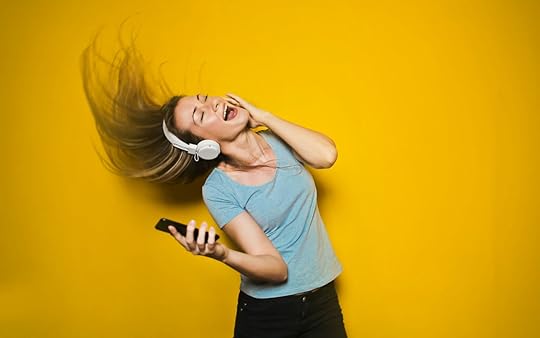
There are a number of benefits to memorizing lyrics. Let’s take a look at the six top reasons.
1. Improves Verbal Memory
You want to improve your memory, right? That’s why we’re all here — and as fans of improving memory, it’s important to improve verbal memory.
A 2013 study shows that instrumental music training can enhance cognitive processing. Their results confirm previous findings concerning music training and cognitive performance.
I’ll reference science a fair amount any time it comes to memory because it’s very important to know that this stuff works (and that it’s been verified by scientific studies, such as how you can improve your crystal and fluid intelligence).
2. Promotes Emotional Stability
Above and beyond improving verbal memory, memorizing songs also promotes emotional stability.
Memorization aids in the production of certain chemicals in the brain — we’ll talk more about neuroscience later in this post.
But for now, just know that memorizing songs can help you feel better. I don’t know about you, but I think we would all like to have better emotions!
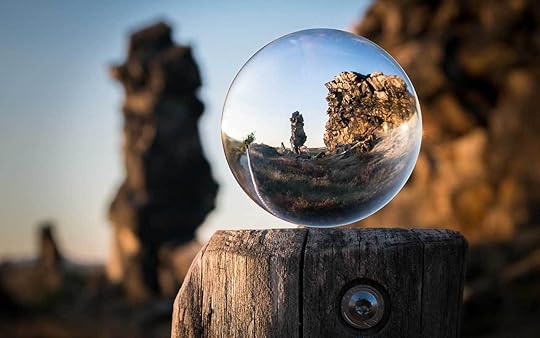
3. Creates Focus & Concentration
Improving your emotions leads to a better mindset. It helps you have better interactions with other people. And it creates more focus and concentration.
Ever since I started working on memorizing songs here at home, I’ve noticed much better focus and concentration. And, very important to me, I’ve had more emotional stability.
4. Bonds Us With Others
Memorizing songs also helps us bond more with other people.
There could be many reasons for this, but one of the examples I find most fascinating is when members of a choir show synchronized heartbeats.
My wife and I sing together quite a bit, usually in different languages, which helps promote the benefits of bilingualism for lifelong brain and memory health.
I also think our singing is a huge part of why we’re so happy as a couple. One of our favorite songs to sing together is “The Moon Represents My Heart” — which I sang to her and her entire family at our wedding party in Beijing.
https://www.youtube.com/watch?v=dCyPV...
5. Produces Health
There are a number of interesting health benefits to learning to sing and memorizing songs.
For example:
Gunter Kreutz, a German professor of Systematische Musikwissenschaften, talks about how you get an oxytocin boost (essentially a high in your brain) when you sing.
For those who don’t speak German, Systematische Musikwissenschaften is a combined physical and mental activity that leads to a more enjoyable mind.
So this is very powerful to have — who wouldn’t want a more enjoyable mind? No matter how enjoyable your mind might be, wouldn’t you want it to be even more enjoyable?
You can also improve your immune system by singing. There’s an article published by the University of California Press that details results from a study designed to determine whether choral singing is associated with physiological changes in the immune system.
6. Improves Breathing, Posture, and Pain Relief
And finally, memorizing songs can improve your breathing and your posture, as well as promoting pain relief.
Stop for a moment and check your posture, right now. Could you benefit from better posture?
Now, before we get much further, it’s important to make sure we’re all talking about the same thing.
What Is a Song?
Let’s talk about the definition of a song. What exactly are we memorizing?
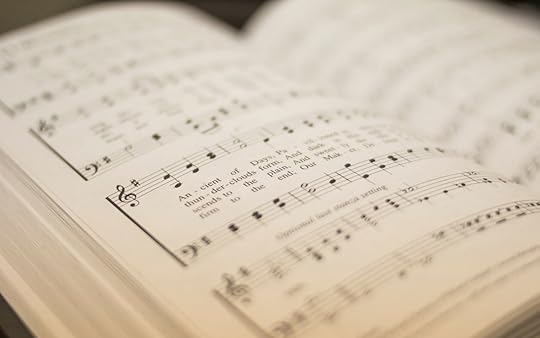
The reason we want to do this is because it’s a tool of memorization to think a little bit about what songs are.
The Definition of a Song
The dictionary definition of a song is:
“A short metrical composition intended or adapted for singing, especially one in rhymed stanzas; a lyric, a ballad, etc.”
It can be helpful to your memorization to know whether what you’re memorizing is a ballad. It’s useful to know whether it’s a standard lyric (or not). And the genre of the song matters, as well.
These are all mental tools to help you learn how to memorize songs.
The first thing you want to understand is the structure of the song.
Song Structure and Mapping
All songs have structures. And different songs will be structured differently — but it’s still important to understand as you memorize.
Before you begin to memorize, you will do what’s called “song mapping” to identify the A part, B part, C part, etc. That way, if you lose your place while singing it’s easier to find your way back.
This has been incredibly useful for me in my musical career.
When I was on tour with The Outside, there were shows where we were all incredibly tired. And no matter how well-practiced we were, there were times we’d lose our spots. But since I did song mapping, I was always able to find my way back quite easily — and a lot faster than I might have without it.

When most people think about memorizing a song, they focus on how to memorize song lyrics.
To help you out with this, let’s look at lyrical analysis.
Lyric Analysis
There are 5 different ways to analyze the song lyrics you’re trying to memorize.
1. Poetic Analysis
This involves looking at the words themselves and asking the following questions:
How do they work?
Is there assonance?
Is there consonance?
Is there logopoeia (paying attention to context)?
What’s the logic of this material?
You don’t have to have a full understanding of the lyrics in order to memorize them, but it’s helpful to understand at least the basics.
But watch out: don’t sit there and wait until you understand the lyrics before you start to memorize! One of the things you’ll discover, through the process of memorizing music, is your understanding compounds value.
In academia, the accretion of value means that “the sediments of meaning build up.” The more you work with little bits of sand and stone (in this case, lyrics and music), the more settle and get baked in, the more and more meaning builds up over time.
There’s always more understanding yet to come — and that’s a beautiful thing.

2. Emotional Analysis
This is the simplest of the types. Ask yourself:
Is it a happy song?
Is it a sad song?
Are there multiple emotions?
What emotions is the artist trying to get across to the audience?
Do your best to interpret what’s going on with the song.
3. Character Analysis
Do the song lyrics suggest character progression?
Since this might be a little hard to understand at first glance, let’s take a look at an example.
Lou Reed’s song “My House” has a line at the end of the first stanza that reads, “My house is very beautiful at night.” But by the end of the song, that lyric has changed to, “Our house is very beautiful at night.”
The character in the song begins it alone, but he shows growth as a result of the process he sings about.
When you identify details like this in a song, it can help you sing it better once memorized.

4. Historical Analysis
Understanding the history behind the song lyrics can also be quite helpful. Do the following research:
Read the Wikipedia page about the song.
Read or listen to interviews with the author.
Read interpretations by other people about what the song means.
By digging deeper into the origin story of the song and the history of the songwriter, you can uncover revelations you might otherwise miss.
5. Melody Analysis
Understanding all parts of the melodic structure is also helpful on your memorization journey. Pay attention to the:
Melody
Harmony
Rhythm
Chords
Flourishes
If you want to dive deeper into melodic analysis, check out Rick Beato’s Everything Music YouTube channel.
All 5 of these types of analysis will help not only your memorization, but also your delivery and enjoyment.
Next, let’s look at the nuts and bolts of memorizing lyrics.
How to Memorize Lyrics: 2 Ways
I believe that memorizing lyrics is a singer’s secret weapon, so let’s look at the two most common approaches.

First, there’s rote repetition. And then there’s mnemonics. Both are really their own worlds, so to speak. But there are some similarities to the approaches.
One key to memorizing lyrics is to immerse yourself in the song. By immersion, I mean listening to the song while you’re walking, going to the gym, cooking, sleeping… spending so much time listening to the song it’s almost like you start to live and breathe it.
For example, when I was memorizing the very long Upadesa Saram and Ribhu Gita, I listened to both of them quite a bit.
To be honest, I listened to the Upadesa Saram a lot more than Ribhu Gita, but that’s because the copy of Ribhu Gita I have is not really sung — instead, it’s the audio of the extracts that Gary Weber has in Evolving Beyond Thought that I turned into a song.
But you can listen to sung versions of Upadesa Saram on the internet. And so I listened to it over and over, while I was in the kitchen and walking around.
Any time you memorize the lyrics to long and complex songs, immersion becomes very important.
Now let’s look at each memorization approach, starting with rote repetition.
Rote repetition
I generally don’t use rote repetition, but I do want to talk about the approach just a bit so you know what to watch out for. There are a myriad number of suggestions online, and many of them seem quite impractical.
I don’t know what will work for you, but a lot of the rote repetition approaches don’t seem to make sense compared to a dedicated mnemonics strategy.

Here are some common recommendations to help you memorize lyrics by rote repetition:
Try dedicated practice,
Use index cards or flashcards, or
Focus on the first and last word of each line.
This last piece of advice is kind of related to keyword selection (which we’ll talk about in a moment), but I honestly don’t know why you would do first-word last-word. Some of those words wouldn’t necessarily be useful in memorizing the entire phrase.
Some people would also say to focus on the first and last lines of a stanza… but I also don’t think that’s very helpful.
Here’s why: primacy effect and recency effect.
Because you’re placing so much emphasis on what are essentially key wordings of particular patterns in a display of words on the screen, then you’re more likely to get tripped up.
Nelson Dellis recorded an interesting video about how to memorize random text word for word (something he deals with in memory competitions), that could potentially be helpful in this context.
Moving on, regular readers know I’m not a fan of using index cards.
One exception: you could write out one line or stanza on a card, and then repeat your exposure to it over and over again. I don’t think that’s a great strategy for any learning speed — but it might be a useful alternative to listening to the song again and again.
The index card approach would let you look at parts of the lyrics in isolation. And if you’re dividing the song into a part A, B, and C, you could break those parts up on index cards.
At the end of the day, rote repetition is going to require a lot of dedicated practice.
But what’s the alternative?
Mnemonics
Regular readers will probably know what’s coming next when I talk about mnemonics…
A Memory Palace is an excellent technique to help you learn how to memorize song lyrics. It’s a very powerful way of laying out your text word by word, in the order it appears (and the order it needs to be recalled). Then you can quickly transfer that information into your long-term memory.
And when you use mnemonics to memorize lyrics, you need a Memory Palace. (Ideally, you’ll already have a Memory Palace you’re familiar with.)
But if you’re not, and you want to learn more about how to create a Memory Palace, you can sign up for my free training here:
You need associative magnetic imagery, you need to know what recall rehearsal is and be able to use it, and you need the Big Five — speaking, writing, reading, and listening in a way that both draws from and puts information into your memory (memory being the 5th of the big five).

There are also a few basic principles to help you make the most of your Memory Palace:
1. Have enough space available
Make sure your Memory Palace has more space than you think you’ll need. For memorizing a song, you’ll want at least 5 or 10 lines more than you imagine.
When I was memorizing the Upadesa Saram, I had to invent a new building to tack on so I could remember all the lines. It worked out, but it’s certainly not best practice!
2. Don’t cross your paths
Especially when you have a Memory Palace that’s big enough to hold complex lyrics, it’s important to make sure not to cross paths as you’re moving around.
I teach all kinds of wonderful principles in the free Memory Palace training and my other courses, to help you create the best path through.
3. Create your imagery
I personally like to submit myself to the theme. So instead of deciding to have one image per word, or pretending like it’s a memory competition, I let the situation decide.
There are many times when you can get multiple words into an image. I’ve been able to get up to 17 words on a single station with maybe 3 to 5 images. There are other times where I had to use five stations, with one word per station.
It’s a lot faster to go with the flow than to design some “system” that doesn’t ultimately work.

4. Use emotion to your advantage
You want to end up with the song so ingrained in your memory that you’re interpreting with your own emotions about the song.
Having this interpretive level of understanding is quite helpful when you make a mistake and need to get back to where you were.
Remember that mistakes will happen; it’s your job to make sure your Memory Palace is so good (and practiced so thoroughly) that you can easily find your way back.
5. Start where you are
There’s always an elephant in the room when we start talking about memorization and how long it’s going to take. The answer is… it depends!
I have pre-existing competence with both music and memory techniques. If you’re trying to both learn basic music techniques and memorize lyrics at the same time, understand that you’ll be splitting your focus if you try to learn both at once.
There’s no perfect answer as to which one to start with, but remember that the hunter chasing two rabbits rarely catches either.
Also of note: professional musicians usually have routines deep in their procedural memory and meta-learning skills. They might not need mnemonics to help them remember lyrics, but they can get use out of memory techniques.
And maybe you’re wondering, “but how many times do I have to repeat the information in my Memory Palace stations, once I’ve created them?” This video talks about the rules around memorization and repetition:
https://www.youtube.com/watch?v=8nOwZ...
Now you understand how a Memory Palace can help you memorize your song lyrics, let’s take a look at an example.
Example: The Expert
To help you understand the mnemonic approach to memorizing lyrics, I wrote a song that we’ll break down.
When I performed this on a recent Livestream, I had to memorize both the chords and the words (even though I’m the one who wrote them). It was my first public performance, and I didn’t have any performance practice.
https://youtu.be/M37RoCvtxkQ?t=1905
Here are the lyrics:
I am the expert
I know all the things I’ve been told
I’ve been through the desert
And the sand still feels so cold.
I don’t know why we die
They say it happens in time
I ain’t gonna live that lie
You’ll follow anyone
They need only call your name
You’ll be the first to disappear
When you know you’re the one to blame
You don’t know why you die
They say it happens in time
Are you going to walk that line?
We are the experts
We know all the things we’ve been told
Been through the graveyards
And kissed all the things we’ve been sold
We don’t know why we die
They say it happens in time
Are we going to live that lie?
I ain’t walking that line
Next, let’s break down how I memorized each line in the song (which is pretty much the same process for how I would memorize scripture). Each line in italics below goes into one Memory Palace station:
“I am the expert.”
This starts in the beginning of a well-formed Memory Palace. I just see an eye. And there’s a band called The X, and they’re doing expertise things.
“I know all the things I’ve been told.”
I imagine The Knowledge Network – it used to be Channel 12 when I was a kid – and that’s just what I see. I don’t have anything else in this station.
“I’ve been through the desert.”
I’ve mentioned allusions before. There’s an allusion to the desert that relates to the idea of being an expert in something — so all I really need to do is draw upon that allusion. This is an example of a concept that doesn’t really have a specific image to it, although images do come to mind related to the concept.

“The sand still feels so cold.”
For this image, there’s sand going through the hourglass and it’s so cold it breaks the glass. And you have that wonderful idea of ice going through glass and the sand just keeps falling out. Here I’m using different tools: sound, feelings, and references to things like bands.
“I don’t know why we die. They say it all happens in time. I ain’t gonna live that lie.”
This is very similar, right? So we start with an eye symbol (the all-knowing eye), The Knowledge Network again, and the actual tree symbol of The Knowledge Network starting to die.
“They say it all happens in time.”
In my mind, this doesn’t even need a mnemonic, it’s just so obvious. However, if I needed one I would use Trey Parker shoveling hay over a clock.
“I ain’t gonna live that lie.”
This is an allusion to Johnny Cash. I’m skipping ahead in my own song because later I’m going to say “walk that line.”
“You’ll follow anyone. They need only call your name. You’ll be the first to disappear when you know you’re the one to blame.”
There’s a scene from the Oliver Stone movie The Doors, where The Doors are being instructed very quickly they’re to use these lyrics and not these lyrics, and then – of course – Jim Morrison does what he wants to do, which is a very funny scene.
“You don’t know why you die. They say it all happens in time. Are you gonna walk that line?”
This is just a simple image of The Knowledge Network again, but this time it’s got the YouTube symbol to remind me it’s now “you” in this version. The new Knowledge Network is maybe a little bit in danger. And then if you needed something to remember “they” you might use something like Trey Parker (sounds like they) pitching hay, and the clock.

“Are you gonna walk that line?”
This is basically asking Johnny Cash if he’s really gonna walk that line.
“We are the experts. We know all the things we’ve been told. Been through the graveyards.”
I know this is a logical thing to change it to “we,” but when I was memorizing lyrics, I would sometimes switch the desert (from the first stanza) with graveyards (from the last stanza), and I had to fix it.
In order to do that, I needed to make sure that this graveyard was very strong, so I went to Castlevania (the video game) which is loaded with graveyards.
“And kissed all the things we’ve been sold.”
The rhyme helps out a lot here, but also just seeing someone kiss the graveyard, like a tombstone.
“We don’t know why we die; they say it happens in time; are we going to live that lie; I ain’t walking that line.”
And finally, the last thing is just a variation on earlier lines.

Now, when you do this, isolate keywords where possible and let grammar fill in the blanks.
For example, you don’t have to have an image for “been through the graveyards.”
There’s this image of the character from Castlevania – he’s going through graveyards, he’s been through the graveyards – that just takes care of everything, and that’s why Castlevania is also what probably came to mind instead of seeing Robert Graves or somebody with a yardstick. That is farther from the potential.
World Memory Champion Mark Channon and I spoke about this years ago: the more you use memory techniques, the more the right image comes at the right time.
One final note before we move to the next step: everything is going to be a sequence.
In the rote learning section, I warned you away from memorizing the first and last words of a sentence via rote learning.
One of the things you might notice in my example above is that I use the symbol of the eye a lot to start off the line. That has a relationship to the rote memorization first-and-last-word strategy, but in this case, you want to think about the force of that image and how it’s going to help you kick off the entire sequence.
Your first “eye” isn’t necessarily going to help you get through the rest of the sentence. So in the line “I am the expert,” having that band The X as an example, the eye needs to be doing something to the expert. There’s entanglement between them in the elaborative encoding.
You don’t want to end up having primacy on just one thing — you want it to have some kind of force that draws things through the sentence. Imagine the sequence as toppling dominoes, where one leads naturally into the other.
Once you have your song lyrics memorized, it’s time to check your memory!
How to Memorize Song Lyrics: Test Yourself!
One of the best ways to determine how much progress you’ve made is to test yourself.
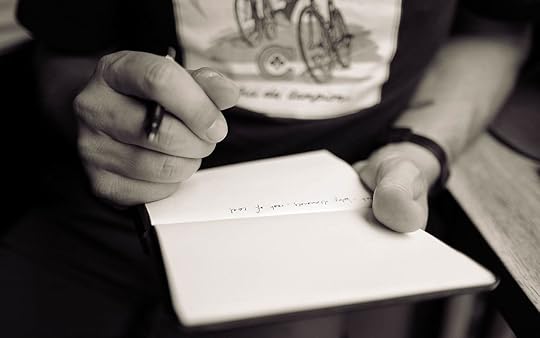
Rather than just thinking, “oh, I’ve got this,” take the time to verify how it’s going. You can test your memory by:
Writing out the lyrics (by hand) from memory,
Record yourself singing the lyrics, and then
Sing along with the recording.
Ideally, you’ll step away from any notes or sheet music while you’re testing. And, don’t worry about mistakes. Just write out what you think the lyrics are, based on what you’ve memorized so far.
You might end up with distortions where words appear in the wrong place. For example, “The mist is hanging gently on the lake,” versus “A gentle mist is hanging on the lake.” Any time you make a mistake, make a note of it and strategize how to fix it.
Singing along with the recording should happen after you’re done writing down or recording yourself.
Next, you’ll troubleshoot.
How to Memorize Song Lyrics: Troubleshoot Your Mistakes
Troubleshooting requires attention to every single step and revising your practice in every possible way.
Ask yourself:
Is my Memory Palace well-formed?
Is my magnetic imagery plump and robust?
Am I using all the Magnetic Modes?
Am I doing Recall Rehearsal effectively?
Am I using the Big Five?
Am I writing or speaking it out?
Am I listening to it?
And finally: are you doing all of these things in a way that promotes drawing from your memory (and putting it back in) with creative elaboration?

Whether you’re using word-by-word or isolating keywords, you want to fix the issues with mnemonics as you go into testing.
Additionally, you will need to do dedicated practice to fix the places where you make mistakes.
Zone in on what the mistake is, and put it on a loop. Take one word at a time, and then two. Then once those two words are comfortable, expand to three… and so on. This will help you get better at the whole thing.
This is the case no matter where in the phrase the mistake happens. It could be a mistake at the beginning, middle, or end of the sentence. Pick that one spot and then repeat it until you “get it” using your imagery.
For example: let’s say there are 3 problematic words in the middle of a 10-word sentence. You would first go in and get one word perfect, nail the mnemonics, and then take the word before or after it and loop it. Loop the words, then the phrases, until you’re able to get the correct lyrics into your long-term memory.
How to Memorize a Song Fast Using Mnemonics?
We’ve mostly covered this question, but there are a couple of things we haven’t touched on yet.

First, dig your wells before you’re thirsty! You’ll hear me say this over and over, but it’s true.
Make sure you have your Memory Palace ready.
Make sure you know the ins and outs of magnetic imagery.
Make sure you’re well trained and have a robust practice.
Then, you can let go of the outcomes and just enjoy the ride. Be F.R.E.E!
When it’s time to perform, just let it go and dive in. You have to be there, in the moment. Breathe. Relax. Let it go!
Now you know how to memorize lyrics, but what if you also need to play guitar or piano (or another instrument) to accompany your performance?
Next, let’s look at the process for memorizing notes.
Memorizing Notes
When it comes to our overarching goal – to memorize a song – where do you start? Do you memorize the lyrics first? The notes? The chords?
If you’re going to play the song as well as sing it, I would actually recommend memorizing the music first, and then the lyrics.
That way, you know the chord progressions and can play along while you practice learning and memorizing the lyrics.

Here are five approaches to help you memorize notes:
1. Have a Song Key
This means knowing the notes of the song. Then, if you have any sort of musical sensibility, you can just match and figure it out.
For example, if I knew the notes and key of a particular Slayer song, then I would try and hear where it matched with another song and try to figure out the notes that way.
Scott Devine, a great bass instructor, teaches this way. He talks about using Stand By Me as a song key — first, wanting to know what key it’s in, then knowing what notes are in it, as well as the root note.
So you learn the notes of one song, and then you match them mentally in your mind.
2. Use a Major System
This approach depends on the instrument and your existing competence with both your instrument and memory techniques.
This is not a be-all-end-all solution, but I find it interesting and fun.
Zero is a soft C, S, or Z.
One is D or T.
Two is N.
Three is M.
Four is R.
Five is L.
Six can be any of these designations – ch, j, soft G, sh.
Seven is a hard G or a K. (I never use the hard G myself.)
Eight is an F or V.
Nine is a B or P.
When Simon Luisi was on the podcast, he shared some amazing suggestions around expanding your Major System.

3. Use an Alphabet List
Let’s look at how you might use the alphabet list as a guitar player.
You will have a designation for every string:
E is Ernie (or dark Ernie)
A is Al Pacino
D is Dracula
G is Grover (from Sesame Street)
B is Bob (from What About Bob)
E (again) can be Ernie again — or light Ernie
Once you have your strings labeled, then you’ll assign an image to each fret.
For example, when you know you have a D on the fifth fret, then you need to have an image for the fifth fret.
If you have your 00 to 99, this would be Sal from Dog Day Afternoon for me. And this is now the third fret on the D string. For the A string, Al Pacino will interact on the D with Sal from Dog Day Afternoon. So we can have a sandwich interacting with Dracula. So Al Pacino, Dracula, then Sal from Dog Day Afternoon.
You just make these little stories that help you remember which notes or chords come next. I’ve never used this approach to memorize an entire song, but it’s helpful for smaller passages.
4. Use Hammers and Knives
When you have to memorize notes with a sharp or flat (accidentals), you can use imagery to help.
Flat = hammer
Sharp = knife
Let’s say you have a C♯ followed by an A♭— you could imagine Cookie Monster using his knife to cut off Al Pacino’s hammer.

5. Use Visuals For the Keyboard
Here’s one way to visualize the notes on a piano keyboard:
C, D, and E are 3 white notes with 2 black keys.
F, G, A, and B are 4 white notes with 3 black keys.
You can think of two houses:
House one has a garage. There’s a Cat and an Elephant who guard the Dog (CDE).
House two has 2 garages. In this one, a Falcon and a Bear guard the Giraffe and Ape inside (FGAB).
You can also use the Major System to number each key. This process is quite detailed, but I explain it fully in the Magnetic Memory Masterclass.
Let’s look at a couple of other strategies before we tie everything together.
Memorizing Chords
Like I mentioned in the last section, I would recommend memorizing the chords before you move along to lyrics.
You can use some of the strategies above to help you memorize chords: using a pegword method or an alphabet list.

For example, if you were memorizing in E minor, you could visualize a miner’s helmet. Then, if you switched into A minor, you could have Ernie pop the hat onto Al Pacino’s head.
Or if you have augmented or diminished chords in your song, you might have the calendar page from August and Dim from A Clockwork Orange in your imagery.
You can also use transcription practice to help you memorize the chords. This has a couple of benefits:
You’ll understand the key structure better.
You’ll get the A, B, and C parts more focused in your mind.
Writing it out from memory helps move the chords into long-term memory.
You’ll also want to practice the performance itself as a separate skill. Private practice is not the same as performing in front of an audience!
Finally, let’s tie all the pieces together.
How to Memorize Songs: Bring It All Together
For this final step, you’ll pick a strategy and be all in. My recommendation? Use mnemonics.
And to get to the place where you can perform without worrying so much about making a mistake, it helps to be F.R.E.E.
Focus on frequent practice, be in a state of relaxation, treat everything like an experiment, and do it in a way that’s entertaining!
And then it all comes back to the principle from earlier in the post: let go of the outcomes.

Remember: all performers make mistakes. What you need is mental strength and a strategy for making the most of your time memorizing.
Set yourself free by following the rules. Sitting across from me at dinner one night, Tony Buzan told me this. “The rules will set you free.”
So what are your rules for memorizing a song? Frequent practice. Relax. Have a spirit of experimentation. And entertain yourself.
Then, once you’ve memorized this song… you can move on to the next one.
Before we wrap up, there are a number of questions I get asked on the topic, so let’s answer them.
Frequently Asked Questions
Have questions about how to memorize a song? Let’s fix that!
1. How many songs can I memorize?
I don’t think there’s really a limit, as long as you’re alive and mentally capable.
As long as you have Memory Palaces, you can memorize as much as you want. You just have to take it one word at a time and one song at a time. If you need help making this practice regular, here’s how to create an UNSHAKABLE Memory Palace Training Routine.
A lot of people think of the brain like a sponge, where you need to squeeze out old stuff to get anything new in — but I don’t think that’s true. (Especially when you utilize Memory Palaces!)
In The Brain: The Story of You, neuroscientist David Eagleman says that to capture all the information in the brain would require a zettabyte of capacity. That means we have way more room than we need to memorize all the songs we want.
And since there’s a never-ending supply of new Memory Palace locations you can create, you’ll never run out of new places to store lyrics and music.

2. How do I use the mnemonics while performing?
Ideally, you don’t.
Instead, you should use mnemonics to get the lyrics memorized before you perform. And performance also has its own type of muscle memory.
One of the biggest lessons I learned from performing with The Outside was from our drummer Tito — he always said, “if it looks like a mistake, it’s a mistake.”
So instead of saying “whoops!” in the middle of a performance, just pretend like the mistake never happened. Get your place back as quickly as possible, and keep going. If you quickly correct and get back to where you were, there’s a lower chance the audience will notice.
3. What if I get bored of a song?
The short answer is: work on 2 or 3 songs at a time.
The longer answer is, this is largely a mindset issue. If you have the time to memorize songs, then you have the opportunity to be grateful to have this time. To me, being bored feels like a strange conclusion to draw from your situation.
That being said, I think there is such a thing as topic exhaustion. In these situations, I might choose to memorize two songs using the same Memory Palace — the different tune and words can help you renew your interest and give your brain a break with variety.
You can work on 2 or 3 songs at a time, and switch things up any time you start to feel exhausted with one of them. And if you know how to multi-purpose Memory Palaces, use that technique.
4. How do I memorize songs in other languages?
It’s the same process, but you want to bring sound and meaning together with imagery a lot more.
It’s a bit of a trick, but if you can create your magnetic imagery so it reminds you of the sound of the word and the meaning at the same time, it will help you a great deal.
You can also memorize without knowing the meaning. In Hermann Ebbinghaus’s book on memory (Über das Gedächtnis), he seems to say it’s easier to memorize nonsense than it is to memorize meaning. However, knowing the meaning can be helpful with the interpretive step of memorization.

5. Where can I learn more about how to memorize a song?
I’m glad you asked.
How to Memorize a Song: The Zen of Remembering Music
 Do you remember the first time you sang in front of an audience?
Do you remember the first time you sang in front of an audience?
I sure do…
Yeah, I was just a little kid in grade two, and I didn’t have a guitar at the time. But it was still quite the experience.
Picture this: little Anthony, doing show-and-tell. Singing about going to camp and getting sick with watermelons and all kinds of stuff.
It was nerve-wracking then, and I know memorizing songs still ranks high on the list of “things that freak people out.” Performing in public, especially when you’re singing from memory, is probably up there with public speaking.
But there’s good news: you can make the process a lot easier if you use the strategies I explain in this post. I’ll help you memorize songs thoroughly — know the lyrics, the notes, and how to do individual runs or riffs.
Want to know how to memorize a song? Here’s what this post will cover:
Why Sing Memorized Songs?
What Is a Song?
How to Memorize Lyrics: 2 Ways
Memorizing Notes
Memorizing Chords
How to Memorize Songs: Bring It All Together
Frequently Asked Questions
How to Remember a Song For Any Purpose
Ready to flex your memorization muscles? Let’s get started.
Why Sing Memorized Songs?
Before we take a deep dive into the techniques and strategies you can use to memorize a song, you should identify your why. Namely, “why do I want to memorize this song?”

There are a number of benefits to memorizing songs and lyrics. Let’s take a look at the six top reasons.
1. Improves Verbal Memory
You want to improve your memory, right? That’s why we’re all here — and as fans of improving memory, it’s important to improve verbal memory.
A 2013 study shows that instrumental music training can enhance cognitive processing. Their results confirm previous findings concerning music training and cognitive performance.
I’ll reference science a fair amount any time it comes to memory because it’s very important to know that this stuff works (and that it’s been verified by scientific studies, such as how you can improve your crystal and fluid intelligence).
2. Promotes Emotional Stability
Above and beyond improving verbal memory, memorizing songs also promotes emotional stability.
Memorization aids in the production of certain chemicals in the brain — we’ll talk more about neuroscience later in this post.
But for now, just know that memorizing songs can help you feel better. I don’t know about you, but I think we would all like to have better emotions!

3. Creates Focus & Concentration
Improving your emotions leads to a better mindset. It helps you have better interactions with other people. And it creates more focus and concentration.
Ever since I started working on memorizing songs here at home, I’ve noticed much better focus and concentration. And, very important to me, I’ve had more emotional stability.
4. Bonds Us With Others
Memorizing songs also helps us bond more with other people.
There could be many reasons for this, but one of the examples I find most fascinating is when members of a choir show synchronized heartbeats.
My wife and I sing together quite a bit, usually in different languages, which helps promote the benefits of bilingualism for lifelong brain and memory health.
I also think our singing is a huge part of why we’re so happy as a couple. One of our favorite songs to sing together is “The Moon Represents My Heart” — which I sang to her and her entire family at our wedding party in Beijing.
5. Produces Health
There are a number of interesting health benefits to learning to sing and memorizing songs.
For example:
Gunter Kreutz, a German professor of Systematische Musikwissenschaften, talks about how you get an oxytocin boost (essentially a high in your brain) when you sing.
For those who don’t speak German, Systematische Musikwissenschaften is a combined physical and mental activity that leads to a more enjoyable mind.
So this is very powerful to have — who wouldn’t want a more enjoyable mind? No matter how enjoyable your mind might be, wouldn’t you want it to be even more enjoyable?
You can also improve your immune system by singing. There’s an article published by the University of California Press that details results from a study designed to determine whether choral singing is associated with physiological changes in the immune system.
6. Improves Breathing, Posture, and Pain Relief
And finally, memorizing songs can improve your breathing and your posture, as well as promoting pain relief.
Stop for a moment and check your posture, right now. Could you benefit from better posture?
Now, before we get much further, it’s important to make sure we’re all talking about the same thing.
What Is a Song?
Let’s talk about the definition of a song. What exactly are we memorizing?

The reason we want to do this is because it’s a tool of memorization to think a little bit about what songs are.
The Definition of a Song
The dictionary definition of a song is:
“A short metrical composition intended or adapted for singing, especially one in rhymed stanzas; a lyric, a ballad, etc.”
It can be helpful to your memorization to know whether what you’re memorizing is a ballad. It’s useful to know whether it’s a standard lyric (or not). And the genre of the song matters, as well.
These are all mental tools to help you learn how to memorize songs.
The first thing you want to understand is the structure of the song.
Song Structure and Mapping
All songs have structures. And different songs will be structured differently — but it’s still important to understand as you memorize.
Before you begin to memorize, you will do what’s called “song mapping” to identify the A part, B part, C part, etc. That way, if you lose your place while singing it’s easier to find your way back.
This has been incredibly useful for me in my musical career.
When I was on tour with The Outside, there were shows where we were all incredibly tired. And no matter how well-practiced we were, there were times we’d lose our spots. But since I did song mapping, I was always able to find my way back quite easily — and a lot faster than I might have without it.

When most people think about memorizing a song, they focus on how to memorize song lyrics.
To help you out with this, let’s look at lyrical analysis.
Lyric Analysis
There are 5 different ways to analyze the song lyrics you’re trying to memorize.
1. Poetic Analysis
This involves looking at the words themselves and asking the following questions:
How do they work?
Is there assonance?
Is there consonance?
Is there logopoeia (paying attention to context)?
What’s the logic of this material?
You don’t have to have a full understanding of the lyrics in order to memorize them, but it’s helpful to understand at least the basics.
But watch out: don’t sit there and wait until you understand the lyrics before you start to memorize! One of the things you’ll discover, through the process of memorizing music, is your understanding compounds value.
In academia, the accretion of value means that “the sediments of meaning build up.” The more you work with little bits of sand and stone (in this case, lyrics and music), the more settle and get baked in, the more and more meaning builds up over time.
There’s always more understanding yet to come — and that’s a beautiful thing.

2. Emotional Analysis
This is the simplest of the types. Ask yourself:
Is it a happy song?
Is it a sad song?
Are there multiple emotions?
What emotions is the artist trying to get across to the audience?
Do your best to interpret what’s going on with the song.
3. Character Analysis
Do the song lyrics suggest character progression?
Since this might be a little hard to understand at first glance, let’s take a look at an example.
Lou Reed’s song “My House” has a line at the end of the first stanza that reads, “My house is very beautiful at night.” But by the end of the song, that lyric has changed to, “Our house is very beautiful at night.”
The character in the song begins it alone, but he shows growth as a result of the process he sings about.
When you identify details like this in a song, it can help you sing it better once memorized.

4. Historical Analysis
Understanding the history behind the song lyrics can also be quite helpful. Do the following research:
Read the Wikipedia page about the song.
Read or listen to interviews with the author.
Read interpretations by other people about what the song means.
By digging deeper into the origin story of the song and the history of the songwriter, you can uncover revelations you might otherwise miss.
5. Melody Analysis
Understanding all parts of the melodic structure is also helpful on your memorization journey. Pay attention to the:
Melody
Harmony
Rhythm
Chords
Flourishes
If you want to dive deeper into melodic analysis, check out Rick Beato’s Everything Music YouTube channel.
All 5 of these types of analysis will help not only your memorization, but also your delivery and enjoyment.
Next, let’s look at the nuts and bolts of memorizing lyrics.
How to Memorize Lyrics: 2 Ways
I believe that memorizing lyrics is a singer’s secret weapon, so let’s look at the two most common approaches.

First, there’s rote repetition. And then there’s mnemonics. Both are really their own worlds, so to speak. But there are some similarities to the approaches.
One key to memorizing lyrics is to immerse yourself in the song. By immersion, I mean listening to the song while you’re walking, going to the gym, cooking, sleeping… spending so much time listening to the song it’s almost like you start to live and breathe it.
For example, when I was memorizing the very long Upadesa Saram and Ribhu Gita, I listened to both of them quite a bit.
To be honest, I listened to the Upadesa Saram a lot more than Ribhu Gita, but that’s because the copy of Ribhu Gita I have is not really sung — instead, it’s the audio of the extracts that Gary Weber has in Evolving Beyond Thought that I turned into a song.
But you can listen to sung versions of Upadesa Saram on the internet. And so I listened to it over and over, while I was in the kitchen and walking around.
Any time you memorize the lyrics to long and complex songs, immersion becomes very important.
Now let’s look at each memorization approach, starting with rote repetition.
Rote repetition
I generally don’t use rote repetition, but I do want to talk about the approach just a bit so you know what to watch out for. There are a myriad number of suggestions online, and many of them seem quite impractical.
I don’t know what will work for you, but a lot of the rote repetition approaches don’t seem to make sense compared to a dedicated mnemonics strategy.

Here are some common recommendations to help you memorize lyrics by rote repetition:
Try dedicated practice,
Use index cards or flashcards, or
Focus on the first and last word of each line.
This last piece of advice is kind of related to keyword selection (which we’ll talk about in a moment), but I honestly don’t know why you would do first-word last-word. Some of those words wouldn’t necessarily be useful in memorizing the entire phrase.
Some people would also say to focus on the first and last lines of a stanza… but I also don’t think that’s very helpful.
Here’s why: primacy effect and recency effect.
Because you’re placing so much emphasis on what are essentially key wordings of particular patterns in a display of words on the screen, then you’re more likely to get tripped up.
Nelson Dellis recorded an interesting video about how to memorize random text word for word (something he deals with in memory competitions), that could potentially be helpful in this context.
Moving on, regular readers know I’m not a fan of using index cards.
One exception: you could write out one line or stanza on a card, and then repeat your exposure to it over and over again. I don’t think that’s a great strategy for any learning speed — but it might be a useful alternative to listening to the song again and again.
The index card approach would let you look at parts of the lyrics in isolation. And if you’re dividing the song into a part A, B, and C, you could break those parts up on index cards.
At the end of the day, rote repetition is going to require a lot of dedicated practice.
But what’s the alternative?
Mnemonics
Regular readers will probably know what’s coming next when I talk about mnemonics…
A Memory Palace is an excellent technique to help you learn how to memorize song lyrics. It’s a very powerful way of laying out your text word by word, in the order it appears (and the order it needs to be recalled). Then you can quickly transfer that information into your long-term memory.
And when you use mnemonics to memorize lyrics, you need a Memory Palace. (Ideally, you’ll already have a Memory Palace you’re familiar with.)
But if you’re not, and you want to learn more about how to create a Memory Palace, you can sign up for my free training here:
You need associative magnetic imagery, you need to know what recall rehearsal is and be able to use it, and you need the Big Five — speaking, writing, reading, and listening in a way that both draws from and puts information into your memory (memory being the 5th of the big five).

There are also a few basic principles to help you make the most of your Memory Palace:
1. Have enough space available
Make sure your Memory Palace has more space than you think you’ll need. For memorizing a song, you’ll want at least 5 or 10 lines more than you imagine.
When I was memorizing the Upadesa Saram, I had to invent a new building to tack on so I could remember all the lines. It worked out, but it’s certainly not best practice!
2. Don’t cross your paths
Especially when you have a Memory Palace that’s big enough to hold complex lyrics, it’s important to make sure not to cross paths as you’re moving around.
I teach all kinds of wonderful principles in the free Memory Palace training and my other courses, to help you create the best path through.
3. Create your imagery
I personally like to submit myself to the theme. So instead of deciding to have one image per word, or pretending like it’s a memory competition, I let the situation decide.
There are many times when you can get multiple words into an image. I’ve been able to get up to 17 words on a single station with maybe 3 to 5 images. There are other times where I had to use five stations, with one word per station.
It’s a lot faster to go with the flow than to design some “system” that doesn’t ultimately work.

4. Use emotion to your advantage
You want to end up with the song so ingrained in your memory that you’re interpreting with your own emotions about the song.
Having this interpretive level of understanding is quite helpful when you make a mistake and need to get back to where you were.
Remember that mistakes will happen; it’s your job to make sure your Memory Palace is so good (and practiced so thoroughly) that you can easily find your way back.
5. Start where you are
There’s always an elephant in the room when we start talking about memorization and how long it’s going to take. The answer is… it depends!
I have pre-existing competence with both music and memory techniques. If you’re trying to both learn basic music techniques and memorize lyrics at the same time, understand that you’ll be splitting your focus if you try to learn both at once.
There’s no perfect answer as to which one to start with, but remember that the hunter chasing two rabbits rarely catches either.
Also of note: professional musicians usually have routines deep in their procedural memory and meta-learning skills. They might not need mnemonics to help them remember lyrics, but they can get use out of memory techniques.
And maybe you’re wondering, “but how many times do I have to repeat the information in my Memory Palace stations, once I’ve created them?” This video talks about the rules around memorization and repetition:
Now you understand how a Memory Palace can help you memorize your song lyrics, let’s take a look at an example.
Example: The Expert
To help you understand the mnemonic approach to memorizing lyrics, I wrote a song that we’ll break down.
When I performed this on a recent Livestream, I had to memorize both the chords and the words (even though I’m the one who wrote them). It was my first public performance, and I didn’t have any performance practice.
Here are the lyrics:
I am the expert
I know all the things I’ve been told
I’ve been through the desert
And the sand still feels so cold.
I don’t know why we die
They say it happens in time
I ain’t gonna live that lie
You’ll follow anyone
They need only call your name
You’ll be the first to disappear
When you know you’re the one to blame
You don’t know why you die
They say it happens in time
Are you going to walk that line?
We are the experts
We know all the things we’ve been told
Been through the graveyards
And kissed all the things we’ve been sold
We don’t know why we die
They say it happens in time
Are we going to live that lie?
I ain’t walking that line
Next, let’s break down how I memorized each line in the song (which is pretty much the same process for how I would memorize scripture). Each line in italics below goes into one Memory Palace station:
“I am the expert.”
This starts in the beginning of a well-formed Memory Palace. I just see an eye. And there’s a band called The X, and they’re doing expertise things.
“I know all the things I’ve been told.”
I imagine The Knowledge Network – it used to be Channel 12 when I was a kid – and that’s just what I see. I don’t have anything else in this station.
“I’ve been through the desert.”
I’ve mentioned allusions before. There’s an allusion to the desert that relates to the idea of being an expert in something — so all I really need to do is draw upon that allusion. This is an example of a concept that doesn’t really have a specific image to it, although images do come to mind related to the concept.

“The sand still feels so cold.”
For this image, there’s sand going through the hourglass and it’s so cold it breaks the glass. And you have that wonderful idea of ice going through glass and the sand just keeps falling out. Here I’m using different tools: sound, feelings, and references to things like bands.
“I don’t know why we die. They say it all happens in time. I ain’t gonna live that lie.”
This is very similar, right? So we start with an eye symbol (the all-knowing eye), The Knowledge Network again, and the actual tree symbol of The Knowledge Network starting to die.
“They say it all happens in time.”
In my mind, this doesn’t even need a mnemonic, it’s just so obvious. However, if I needed one I would use Trey Parker shoveling hay over a clock.
“I ain’t gonna live that lie.”
This is an allusion to Johnny Cash. I’m skipping ahead in my own song because later I’m going to say “walk that line.”
“You’ll follow anyone. They need only call your name. You’ll be the first to disappear when you know you’re the one to blame.”
There’s a scene from the Oliver Stone movie The Doors, where The Doors are being instructed very quickly they’re to use these lyrics and not these lyrics, and then – of course – Jim Morrison does what he wants to do, which is a very funny scene.
“You don’t know why you die. They say it all happens in time. Are you gonna walk that line?”
This is just a simple image of The Knowledge Network again, but this time it’s got the YouTube symbol to remind me it’s now “you” in this version. The new Knowledge Network is maybe a little bit in danger. And then if you needed something to remember “they” you might use something like Trey Parker (sounds like they) pitching hay, and the clock.

“Are you gonna walk that line?”
This is basically asking Johnny Cash if he’s really gonna walk that line.
“We are the experts. We know all the things we’ve been told. Been through the graveyards.”
I know this is a logical thing to change it to “we,” but when I was learning my own lyrics and memorizing them I would sometimes switch the desert (from the first stanza) with graveyards (from the last stanza), and I had to fix it.
In order to do that, I needed to make sure that this graveyard was very strong, so I went to Castlevania (the video game) which is loaded with graveyards.
“And kissed all the things we’ve been sold.”
The rhyme helps out a lot here, but also just seeing someone kiss the graveyard, like a tombstone.
“We don’t know why we die; they say it happens in time; are we going to live that lie; I ain’t walking that line.”
And finally, the last thing is just a variation on earlier lines.

Now, when you do this, isolate keywords where possible and let grammar fill in the blanks.
For example, you don’t have to have an image for “been through the graveyards.”
There’s this image of the character from Castlevania – he’s going through graveyards, he’s been through the graveyards – that just takes care of everything, and that’s why Castlevania is also what probably came to mind instead of seeing Robert Graves or somebody with a yardstick. That is farther from the potential.
World Memory Champion Mark Channon and I spoke about this years ago: the more you use memory techniques, the more the right image comes at the right time.
One final note before we move to the next step: everything is going to be a sequence.
In the rote learning section, I warned you away from memorizing the first and last words of a sentence via rote learning.
One of the things you might notice in my example above is that I use the symbol of the eye a lot to start off the line. That has a relationship to the rote memorization first-and-last-word strategy, but in this case, you want to think about the force of that image and how it’s going to help you kick off the entire sequence.
Your first “eye” isn’t necessarily going to help you get through the rest of the sentence. So in the line “I am the expert,” having that band The X as an example, the eye needs to be doing something to the expert. There’s entanglement between them in the elaborative encoding.
You don’t want to end up having primacy on just one thing — you want it to have some kind of force that draws things through the sentence. Imagine the sequence as toppling dominoes, where one leads naturally into the other.
Once you have your song lyrics memorized, it’s time to check your memory!
How to Memorize Song Lyrics: Test Yourself!
One of the best ways to determine how much progress you’ve made is to test yourself.

Rather than just thinking, “oh, I’ve got this,” take the time to verify how it’s going. You can test your memory by:
Writing out the lyrics (by hand) from memory,
Record yourself singing the lyrics, and then
Sing along with the recording.
Ideally, you’ll step away from any notes or sheet music while you’re testing. And, don’t worry about mistakes. Just write out what you think the lyrics are, based on what you’ve memorized so far.
You might end up with distortions where words appear in the wrong place. For example, “The mist is hanging gently on the lake,” versus “A gentle mist is hanging on the lake.” Any time you make a mistake, make a note of it and strategize how to fix it.
Singing along with the recording should happen after you’re done writing down or recording yourself.
Next, you’ll troubleshoot.
How to Memorize Song Lyrics: Troubleshoot Your Mistakes
Troubleshooting requires attention to every single step and revising your practice in every possible way.
Ask yourself:
Is my Memory Palace well-formed?
Is my magnetic imagery plump and robust?
Am I using all the Magnetic Modes?
Am I doing Recall Rehearsal effectively?
Am I using the Big Five?
Am I writing or speaking it out?
Am I listening to it?
And finally: are you doing all of these things in a way that promotes drawing from your memory (and putting it back in) with creative elaboration?

Whether you’re using word-by-word or isolating keywords, you want to fix the issues with mnemonics as you go into testing.
Additionally, you will need to do dedicated practice to fix the places where you make mistakes.
Zone in on what the mistake is, and put it on a loop. Take one word at a time, and then two. Then once those two words are comfortable, expand to three… and so on. This will help you get better at the whole thing.
This is the case no matter where in the phrase the mistake happens. It could be a mistake at the beginning, middle, or end of the sentence. Pick that one spot and then repeat it until you “get it” using your imagery.
For example: let’s say there are 3 problematic words in the middle of a 10-word sentence. You would first go in and get one word perfect, nail the mnemonics, and then take the word before or after it and loop it. Loop the words, then the phrases, until you’re able to get the correct lyrics into your long-term memory.
How to Memorize a Song Fast Using Mnemonics?
We’ve mostly covered this question, but there are a couple of things we haven’t touched on yet.

First, dig your wells before you’re thirsty! You’ll hear me say this over and over, but it’s true.
Make sure you have your Memory Palace ready.
Make sure you know the ins and outs of magnetic imagery.
Make sure you’re well trained and have a robust practice.
Then, you can let go of the outcomes and just enjoy the ride. Be F.R.E.E!
When it’s time to perform, just let it go and dive in. You have to be there, in the moment. Breathe. Relax. Let it go!
Now you know how to memorize lyrics, but what if you also need to play guitar or piano (or another instrument) to accompany your performance?
Next, let’s look at the process for memorizing notes.
Memorizing Notes
When it comes to our overarching goal – to memorize a song – where do you start? Do you memorize the lyrics first? The notes? The chords?
If you’re going to play the song as well as sing it, I would actually recommend memorizing the music first, and then the lyrics.
That way, you know the chord progressions and can play along while you practice learning and memorizing the lyrics.

Here are five approaches to help you memorize notes:
1. Have a Song Key
This means knowing the notes of the song. Then, if you have any sort of musical sensibility, you can just match and figure it out.
For example, if I knew the notes and key of a particular Slayer song, then I would try and hear where it matched with another song and try to figure out the notes that way.
Scott Devine, a great bass instructor, teaches this way. He talks about using Stand By Me as a song key — first, wanting to know what key it’s in, then knowing what notes are in it, as well as the root note.
So you learn the notes of one song, and then you match them mentally in your mind.
2. Use a Major System
This approach depends on the instrument and your existing competence with both your instrument and memory techniques.
This is not a be-all-end-all solution, but I find it interesting and fun.
Zero is a soft C, S, or Z.
One is D or T.
Two is N.
Three is M.
Four is R.
Five is L.
Six can be any of these designations – ch, j, soft G, sh.
Seven is a hard G or a K. (I never use the hard G myself.)
Eight is an F or V.
Nine is a B or P.
When Simon Luisi was on the podcast, he shared some amazing suggestions around expanding your Major System.

3. Use an Alphabet List
Let’s look at how you might use the alphabet list as a guitar player.
You will have a designation for every string:
E is Ernie (or dark Ernie)
A is Al Pacino
D is Dracula
G is Grover (from Sesame Street)
B is Bob (from What About Bob)
E (again) can be Ernie again — or light Ernie
Once you have your strings labeled, then you’ll assign an image to each fret.
For example, when you know you have a D on the fifth fret, then you need to have an image for the fifth fret.
If you have your 00 to 99, this would be Sal from Dog Day Afternoon for me. And this is now the third fret on the D string. For the A string, Al Pacino will interact on the D with Sal from Dog Day Afternoon. So we can have a sandwich interacting with Dracula. So Al Pacino, Dracula, then Sal from Dog Day Afternoon.
You just make these little stories that help you remember which notes or chords come next. I’ve never used this approach to memorize an entire song, but it’s helpful for smaller passages.
4. Use Hammers and Knives
When you have to memorize notes with a sharp or flat (accidentals), you can use imagery to help.
Flat = hammer
Sharp = knife
Let’s say you have a C♯ followed by an A♭— you could imagine Cookie Monster using his knife to cut off Al Pacino’s hammer.

5. Use Visuals For the Keyboard
Here’s one way to visualize the notes on a piano keyboard:
C, D, and E are 3 white notes with 2 black keys.
F, G, A, and B are 4 white notes with 3 black keys.
You can think of two houses:
House one has a garage. There’s a Cat and an Elephant who guard the Dog (CDE).
House two has 2 garages. In this one, a Falcon and a Bear guard the Giraffe and Ape inside (FGAB).
You can also use the Major System to number each key. This process is quite detailed, but I explain it fully in the Magnetic Memory Masterclass.
Let’s look at a couple of other strategies before we tie everything together.
Memorizing Chords
Like I mentioned in the last section, I would recommend memorizing the chords before you move along to lyrics.
You can use some of the strategies above to help you memorize chords: using a pegword method or an alphabet list.

For example, if you were memorizing in E minor, you could visualize a miner’s helmet. Then, if you switched into A minor, you could have Ernie pop the hat onto Al Pacino’s head.
Or if you have augmented or diminished chords in your song, you might have the calendar page from August and Dim from A Clockwork Orange in your imagery.
You can also use transcription practice to help you memorize the chords. This has a couple of benefits:
You’ll understand the key structure better.
You’ll get the A, B, and C parts more focused in your mind.
Writing it out from memory helps move the chords into long-term memory.
You’ll also want to practice the performance itself as a separate skill. Private practice is not the same as performing in front of an audience!
Finally, let’s tie all the pieces together.
How to Memorize Songs: Bring It All Together
For this final step, you’ll pick a strategy and be all in. My recommendation? Use mnemonics.
And to get to the place where you can perform without worrying so much about making a mistake, it helps to be F.R.E.E.
Focus on frequent practice, be in a state of relaxation, treat everything like an experiment, and do it in a way that’s entertaining!
And then it all comes back to the principle from earlier in the post: let go of the outcomes.

Remember: all performers make mistakes. What you need is mental strength and a strategy for making the most of your time memorizing.
Set yourself free by following the rules. Sitting across from me at dinner one night, Tony Buzan told me this. “The rules will set you free.”
So what are your rules for memorizing a song? Frequent practice. Relax. Have a spirit of experimentation. And entertain yourself.
Then, once you’ve memorized this song… you can move on to the next one.
Before we wrap up, there are a number of questions I get asked on the topic, so let’s answer them.
Frequently Asked Questions
Have questions about how to memorize a song? Let’s fix that!
1. How many songs can I memorize?
I don’t think there’s really a limit, as long as you’re alive and mentally capable.
As long as you have Memory Palaces, you can memorize as much as you want. You just have to take it one word at a time and one song at a time. If you need help making this practice regular, here’s how to create an UNSHAKABLE Memory Palace Training Routine.
A lot of people think of the brain like a sponge, where you need to squeeze out old stuff to get anything new in — but I don’t think that’s true. (Especially when you utilize Memory Palaces!)
In The Brain: The Story of You, neuroscientist David Eagleman says that to capture all the information in the brain would require a zettabyte of capacity. That means we have way more room than we need to memorize all the songs we want.
And since there’s a never-ending supply of new Memory Palace locations you can create, you’ll never run out of new places to store lyrics and music.

2. How do I use the mnemonics while performing?
Ideally, you don’t.
Instead, you should use mnemonics to get the lyrics memorized before you perform. And performance also has its own type of muscle memory.
One of the biggest lessons I learned from performing with The Outside was from our drummer Tito — he always said, “if it looks like a mistake, it’s a mistake.”
So instead of saying “whoops!” in the middle of a performance, just pretend like the mistake never happened. Get your place back as quickly as possible, and keep going. If you quickly correct and get back to where you were, there’s a lower chance the audience will notice.
3. What if I get bored of a song?
The short answer is: work on 2 or 3 songs at a time.
The longer answer is, this is largely a mindset issue. If you have the time to memorize songs, then you have the opportunity to be grateful to have this time. To me, being bored feels like a strange conclusion to draw from your situation.
That being said, I think there is such a thing as topic exhaustion. In these situations, I might choose to memorize two songs using the same Memory Palace — the different tune and words can help you renew your interest and give your brain a break with variety.
You can work on 2 or 3 songs at a time, and switch things up any time you start to feel exhausted with one of them. And if you know how to multi-purpose Memory Palaces, use that technique.
4. How do I memorize songs in other languages?
It’s the same process, but you want to bring sound and meaning together with imagery a lot more.
It’s a bit of a trick, but if you can create your magnetic imagery so it reminds you of the sound of the word and the meaning at the same time, it will help you a great deal.
You can also memorize without knowing the meaning. In Hermann Ebbinghaus’s book on memory (Über das Gedächtnis), he seems to say it’s easier to memorize nonsense than it is to memorize meaning. However, knowing the meaning can be helpful with the interpretive step of memorization.

5. Where can I learn more about how to memorize a song?
I’m glad you asked.
April 2, 2020
Boris Konrad On The Benefits Of Scientific Memory Training
 Control.
Control.
In everyday life, or for the layman control is defined as a power to influence or direct others.
If you’re out of control you’re said to be “off the rails,” or too wild to handle. Unpredictable.
But there’s another definition of control.
Control, as defined by science is “a subject or group in an experiment where the factor being tested is not applied, hence serves as a standard for comparison against another group where the factor is applied.”
When it comes to science, control is used to make the data we’re measuring immune to influence. Simple enough, right?
My guest today is Boris Konrad, International Grandmaster of Memory. He is a four time Guinness World Record holder, and lecturer on and teacher of memory.
Professionally, Boris works as a neuroscientist and researcher at Donders Institute in The Netherlands. He is also an award winning keynote speaker of the prestigious German title of “5-Sterne-Rednerpreis.”
In his years of research, Boris has taken the idea of examining the element of control far beyond the constraints of the scientific method.
As a record-setting memory champion he has incorporated a scientific approach to memory improvement, treating his own regimen as an experiment, marrying his experiences in neuroscience to stretching the limits of memory work personally.
In our conversation, Boris shares his story of overlapping profession and self-improvement and how you, too, can serve as your own control, stepping into the role of scientist in the laboratory of your mind, no neuroscience degree necessary.
We talk about all these matters, and so much more that will benefit your memory training. All you have to do is press play above and discover:
What parameters should truly define science as a whole, and what distinguishes scientific guidelines
How neuroscience research began with the work of a single scientist and has evolved into many areas of study
Why retention time is influenced by the method by which information is encoded
How memorizing for competition differs from memorization for the purpose of learning
The tradeoff (and benefits) of investing time into experimenting with new memory techniques in your Memory Palace training routine
What constitutes a real feat of memory (and it may not be what you think!)
How mixing and matching memory techniques can be the most powerful tool for improvement
The reason intelligent spaced repetition works (and why robots aren’t all that bad)
How reusing Memory Palaces is possible without falling prey to the ghosting effect, no modifications required
The cause of spatial memory and how exactly science has recently proven this hypothesis of organization
Why the brain fills in gaps of what it fails to remember
The benefits of solo memory training and using yourself as a control, rather than comparison to others for measured improvement
Further Resources on the Web, this podcast, and the MMM Blog:
Boris Konrad’s Official Website
Superbrain! (Boris Konrad’s forthcoming memory training course)
The post Boris Konrad On The Benefits Of Scientific Memory Training appeared first on Magnetic Memory Method - How to Memorize With A Memory Palace.
March 24, 2020
Selective Attention: 5 Quick Ways to Boost Focus And Memory
 As you sit down to read…
As you sit down to read…
Your Messenger beeps.
An email alert shows up next.
A child wails outside.
And your neighbor decides to practice his Conga drums (very loudly) on this bright, sunny morning!
You need to turn on your selective attention.
Now, where’s the remote to that thing?
Spoiler alert: Getting your selective attention to work impeccably is not as simple as pressing a button. But if you are willing to put in the effort, I have some quick and easy ways to help you master the art of concentration.
In this post, I’ll explain how selective attention works and how you can use it to improve your attention abilities.
Here’s what this post will cover:
Selective Attention: The What, Where, and How?
A Walk Down History: Selective Attention And Its Theories
Are There Different Types of Selective Attention?
The Link Between Selective Attention And Memory
Why You Must Strengthen Your Selective Attention
5 Magnetic Ways to Boost Your Focus & Memory
Ready to get started? Let’s go!
Selective Attention: The What, Where, and How?
Before you can learn how to improve your selective attention, it’s important to understand just what it is.
What Is Selective Attention?
Selective attention is the process of concentrating on certain stimuli in the environment and not on others, according to the American Psychological Association.

This allows you to push all incidental or unnecessary stimuli into the background or to the periphery of your perception, without actually removing the interferences.
So, what is attention, you ask?
In cognitive science, attention is the ability to focus on a particular stimulus, sustaining it and shifting it at will.
There are four types of attention:
1. Divided Attention: Doing more than one task simultaneously.
2. Alternating Attention: Also known as attention switching — where you switch attention between two things.
3. Sustained Attention: Focusing on one thing or activity for a long time.
4. Selective Attention: What if you were able to direct your attention only on your presentation deck – or your novel or your driving – despite all the distractions around you?
That is selective attention.
The amount of selective attention you apply will depend on your capacity to concentrate and the interruptions around you. It can be a conscious or unconscious effort.
In his book The Principles of Psychology, pioneering psychologist William James, famously says:
“Focalization, concentration, of consciousness, is of its essence. It implies withdrawal from some things in order to deal effectively with others and is a condition which has a real opposite in the confused, dazed, scatter-brained state which in French is called distraction, and Zerstreutheit in German.”
Where Do You Use Selective Attention?
Here are some examples of the usage of selective attention ability in everyday life:
Studying or working with the TV switched on.
Listening to a podcast on the radio amid noisy traffic.
Listening only to what the teacher says despite friends talking next to you.
Reading a book or memorizing from a text book without getting disturbed by the noises in a coffee shop.
Hearing the cry of your baby even if you are completely engrossed on your laptop.
Hearing the ambulance siren, and making way for it, even if your attention is on the radio.
How Does Selective Attention Work?
Selective attention in young and older adults is a great example of contextual modulation by the brain and the visual cortex when it faces a cluttered scene (visual, or relating to any of the senses).

Let’s try to understand the neural functions behind selective attention.
Experiments by Basilis Zikopoulos and Helen Barbas of Boston University revealed a pathway from the amygdala to the thalamic reticular nucleus (TRN). The amygdala assesses the physical characteristics and importance of stimuli and relays it to other parts of the brain. TRN is a hub for attentional processing.
Scientist Francis Crick called the TRN an “attentional searchlight” due to its orientation as the primary inhibitor of the sensory thalamus.
More recently, a team of neuroscientists at McGill University led by Julio Martinez-Trujillo also got evidence of a neuron network in the lateral prefrontal cortex of the brain being responsible for visual processing and filtering visual features.
They implanted a multielectrode-array implant (red square) in the lateral prefrontal cortex area (8A) of two macaques. This is where the active neuron network filters visual information and allocates attention, and is resilient to interference.

Source: Neuron
Now that you understand the what, where, and how… let’s look at a few of the models behind selective attention.
A Walk Down History: Selective Attention And Its Theories
Selective attention has been a focus area in the study of experimental psychology. To fully grasp why and how your attention span works, it is important to go through the various theories.

These theories help pinpoint how individuals prioritize and process sensory inputs:
Cherry’s “cocktail party problem”
This was one of the seminal theories on selective attention proposed by cognitive scientist Colin Cherry in 1953. Here, a partygoer listens intently only to his friend in a noisy room filled with conversation and music.
Broadbent’s Filter Model
In his 1958 Filter Model, Donald Broadbent said that a filter (or bottleneck) buffers only the necessary information and blocks or ignores the rest.

Source: Practical Pie
Treisman’s Filter-Attenuation Theory
In 1960, Treisman addressed the fact that unselected information also gets processed by the human brain, but with a lower intensity (a process called attenuation).
These two were bottleneck models. They were also known as early-selection theories.
Late-selection theories of attention entirely dropped the idea of an attentional filter or attenuator.
You can see the difference below:

Source: Berkeley
Anthony Deutsch and Diana Deutsch’s theory
The subjects in their studies analyzed inputs pre-attentively. You pay attention to any information depending on its meaning to your task.
Kahneman’s model
Through his experiments and findings, Kahneman showed that attention is a single mental resource that gets distributed among each task in varying amounts. So at a cocktail party, all your attention would be on friends, but you would respond immediately if someone else called your name.
Next came a few variants to the capacity theories:
Michael Posner’s Spotlight metaphor of attention
During a magician’s performance on stage, all eyes are on him because of the spotlight. You don’t normally look at the rest of the stage (fringe) and the area outside it (margin).
Zoom-Lens metaphor by other scientists
Even if a spotlight weren’t there on the stage, you would still look at the magician, sometimes increasing your visual field to what his support crew is doing.
If you’re interested in learning more about these theories, I recommend tools like Google Scholar to find scholarly literature related to your search.
Next, let’s look at the 4 potential types of selective attention.
Are There Different Types of Selective Attention?
Selective attention can be divided broadly into:
1. Selective Visual Attention: The “spotlight” and “zoom-lens” models of attention describe the idea of selective visual attention, and
2. Selective Auditory Attention: Simply put, this is selective hearing. You focus on a particular sound of your interest despite several other sound stimuli around you.

Nill Lavie and others proposed two other mechanisms of selective attention in their load theory of attention:
1. Perpetual Selection Mechanisms: This happens in a passive or involuntary way when you exclude irrelevant interruptions when there is too much information around you — because your attention capacity is limited.
For example, you’re disinterested in the overload of information in your advanced calculus class and end up doodling in your textbook.
2. Active Attention Control: Here your attentional control rejects interruptions even when you perceive them.
For example, when you work on more than one class assignment at a time, or when you take an open-book advanced calculus test in a noisy school campus.
Is Selective Attention Same As Inattentional Blindness?
Absolutely not!
In inattentional blindness or change blindness, you focus so intently on just one thing you don’t notice anything new that comes into your visual search field.
This can have dangerous effects — especially if it happens while driving a vehicle.
Dichotic listening is a similar aspect of selective attention where you listen to and process different things presented to the two ears.
How Is Selective Attention Related To Arousal?
Selective attention is governed by our arousal level.
Norman CC and others elaborated on Deutsch and Deutsch’s theory that the selection of stimuli depends on the relevance of the sensory input and its strength.
The strength of the input occurs due to the stimulation of any of the sensory systems: visual, auditory, olfactory, or tactile, and is accompanied by arousal.
The connection between selective attention and arousal is circular. An optimum level of arousal causes selective attention based on various aspects of our cognitive capacities and our experiences.
At the same time, our experiences and perceptions of the stimuli also influence our arousal. These stimuli may then increase or decrease arousal, and the cycle continues.
As Nir Eyal points out in Indistractable, you can stop that cycle, however, merely by being more selective about your choices.
The Link Between Selective Attention And Memory
The filter of selective attention saves the human brain from getting overwhelmed with information overload.

It prioritizes what is important for the moment and filters out what is not. It prepares our cognitive processes and actions for each everyday task and in survival.
Selective attention is also closely linked to learning and recall. As is other memory issues, which can be confusing, so make sure to read up on everything you need to erase the confusion around things like explicit memory.
Impact Of Selective Attention On Learning and Memory
Although your cognitive brain gets affected by all your experiences, only a small portion of those experiences are remembered.
Studies have shown that what you encoded using selective attention makes for the strongest memories. This means that you have to first pay attention in order to store what is important to you in your short-term memory and working memory.
Distractors also affect learning and recall.
If there is music playing in the background while you study, your capacity to memorize things goes down a bit.
Music is tied to your associative memory reminding you of things that you had associated the track with. This diverts your attention, making it less likely that you encode what you study.
In effect, the music prevents information from moving from your short-term memory or working memory into your long-term memory.
Why You Must Strengthen Your Selective Attention
If your selective attention is weak, impaired or damaged, you can easily get distracted from your tasks.

If this happens persistently, it can adversely affect your personal, school, or professional life.
Selective attention is often impaired in disorders such as Alzheimer’s disease, schizophrenia, depression, and attention deficit hyperactivity disorder (ADHD).
A specific neural network in the brain is responsible for selective attention. Manipulating the neuronal activity can alter a person’s ability to focus.
This can be used to treat individuals or older adults who get distracted easily or suffer from ADHD, autism, and schizophrenia.
So how can you improve your selective attention?
5 Magnetic Ways to Boost Your Focus & Memory
You can easily strengthen your everyday selective attention – and thereby your focus and recall – using these five magnetic methods.
1. Exercise
Coordinative exercises (those that need coordinated movement of large muscles or muscle-groups) help improve selective attention by pre-activating your cognitive related neuronal networks.
High-Intensity Interval Exercise (HIIE) has been proven to improve selective attention, especially in university students.
They strengthen your body and sharpen your cognitive control at the same time.
When you improve your fitness, your fatigue decreases and your attention span lengthens naturally.

If exercise isn’t in your routine yet, how about adding it in now?
Set aside at least 30 minutes for working out in the morning or evening.
Vary your workouts with running, aerobic exercises, cycling, or any other physical sport that you are interested in. You can also include mind-body exercises like yoga and tai-chi into your routine.
2. Use Focused Attention
In their trials on a few participants, Eduardo Massad and others found that participants were physiologically aroused while doing a Monty Hall Problem (a brain teaser).
This was because the intense decision-making process needed a higher attentional load by the participants.
Paying deliberate attention to your task will let you do it with far more efficiency. Such focused attention on one exercise at a time will lead to better-formed memories and better recall.
Whenever you find the time, participate in activities that demand concentrated attention.
For example, pick the day’s newspaper and engross yourself in sudoku, finding the odd one out, or a crossword puzzle. Or engage in games such as chess, and obstacle courses.
You could even give a TEDx presentation and deliver your speech from memory, as I recently did.
3. Sleep
Sleep and selective attention seem to be polar opposites. But they regulate your awareness by filtering information from your conscious awareness.
In fact, they regulate each other. Sleep is important for you to maintain optimal attention levels. And your need for sleep increases after tasks that engage selective attention.

Sleep also helps in memory consolidation and in reorganizing memories.
Mental fatigue and sleep deprivation can affect your capacity to pay attention, process, and remember information. Sleepless nights can severely impair selective attention.
So snooze for a good 6 to 7 hours every day to wake up sharp and attentive. You will also be more present with whatever you do.
4. Don’t Pay Attention!
Did you read that right?
Yes.
Interestingly, Atsunori Ariga and Alejandro Lleras from the University of Illinois found that repetitive tasks needing prolonged selective attention lead to constant stimulation of the brain.
If it happens continuously, you register it as unimportant and eventually erase it. To prevent this, take short breaks from whatever you are focusing on – including studying for exams – and your attention will last a lot longer.
5. Build Memory Palaces
A Memory Palace is one of the most powerful types of mnemonics.
Here you peg all the information you want to remember in different parts of a familiar place — your home, for instance.

So if you want to remember a history lesson, associate the events of one year to your coffee table, another year to your sofa, and so on. To recall the events in the right order, you simply have to do a mental walk through your home.
In the process, you are forced to pay close attention to each historical event rather than just rehearsing it as it gets etched in your memory.
Practice creating Memory Palaces using the Magnetic Memory Method. Use it to commit everything that’s important to your memory, not allowing any diversions to affect the process.
Paying Attention Matters
Selective attention is needed to perform almost every daily task.
Training yourself to concentrate only on the information you need while averting a sensory overload is an important life skill.
When you combine the power of selective attention with Memory Palaces using the Magnetic Memory Method, you can retain and recall information faster and with superior permanence.
Ready to get started? Sign up for your copy of my free Memory Improvement Kit.
The post Selective Attention: 5 Quick Ways to Boost Focus And Memory appeared first on Magnetic Memory Method - How to Memorize With A Memory Palace.
March 17, 2020
Can You Trust Memory Vitamins To Boost Your Brain?
 Can you really supercharge your memory with memory vitamins?
Can you really supercharge your memory with memory vitamins?
There is a multi-billion-dollar industry touting “advanced nutrition” to “upgrade your intelligence” with a “proprietary blend” of magic nutrients.
Let’s find out if these ginkgo and ginseng pills can improve your cognitive faculties or cure absent-mindedness and dementia, as their labels claim.
In this post, I’ll dive into numerous memory supplements available today, and the truth behind them. I’ll also show you three natural, effective ways that guarantee improved concentration and a razor-sharp memory.
Here’s what I’ll cover:
Why Do We Take Supplements to Boost Memory?
Can Vitamins and Other Supplements Really Help you Improve Memory?
The Truth Behind Memory Supplements
Things to Remember When You Buy Memory Supplements
Do Your Lifestyle Choices Affect Memory?
3 Effective Alternative Ways to Boost Your Memory
Why Do We Take Vitamin Supplements to Boost Memory?
Cleverly packaged and marketed vitamins for memory are too attractive to ignore — thanks to some of the perceived long-term effects and benefits.
Memory vitamins claim to:
Enhance blood flow in your brain.
Boost energy.
Promote communication between brain cells.
Help brain cells form new connections, increasing plasticity.
Increase motivation and creativity.
Improve focus and alertness.
Lower fatigue.
Help in Alzheimer’s prevention and in curing other neurodegenerative diseases.
Prevent oxidative stress in the brain.
Lower the damaging effects of free radicals and brain inflammation, and more.
How true are these claims?
Can Vitamins and Other Nutrients Really Help You Improve Memory?
There are plenty of single-vitamin supplements or proprietary blends available today.

They could be vitamins and minerals (vitamin B, C, D, E, K), herbal extracts (Ginseng, Ginkgo Biloba, Curcumin, Bacopa), natural molecules (Acetyl-L-Carnitine amino acid, Docosahexaenoic Acid, Huperzine A, Magnesium l-threonate) or synthetic compounds (Choline bitartrate).
To understand whether they help, it is important to look at the clinical trials linking them to memory improvement.
Vitamin B:
Vitamins B12, B3, B6, and folic acid slow down cognitive decline, lower high homocysteine levels, and are used in Alzheimer’s treatment. Homocysteine is an amino acid. It is also believed that folate might prevent Parkinson’s disease.
Studies show that these vitamins slow the atrophy of brain regions that are involved in Alzheimer’s disease. However, vitamin B12 and folate supplementation may not always reduce memory problems.
Vitamin E:
This antioxidant lowers oxidative stress in your brain cells.
A study proved that adults with high levels of vitamin E are less likely to suffer from memory disorders including Alzheimer’s and Parkinson’s disease. Alpha-tocopherol (a form of vitamin E) slows down functional decline in people with moderate symptoms of Alzheimer’s disease.

Vitamin D:
This vitamin protects against cognitive decline and dementia, and reduces the risk of heart disease. However, patients suffering from heart disease may not benefit from higher doses of this vitamin.
Older adults who had severe vitamin D deficiency were found to be more likely to develop cognitive disease like dementia and Alzheimer’s disease.
Be aware that excess amounts of this vitamin can lower your reaction time.
Vitamin C:
Apart from cutting your colds short, vitamin C helps improve brain health with its antioxidant properties. It also crosses the blood-brain barrier to remove heavy metals like lead.
Researchers found higher vitamin C levels in those who were cognitively intact versus those who were cognitively impaired.
But it’s not clear how much of it is needed to support cognitive function. Also, your intake may not always translate into enough of the vitamin in your blood. Check out this Chief Life article for more on the benefits of Vitamin C.

Vitamin K:
High levels of this vitamin are known to improve verbal episodic memory in older adults.
Elders with early-stage Alzheimer’s disease were observed to have a deficiency of this vitamin.
High doses can worsen clotting problems in those who have severe liver ailments.
Ginkgo biloba:
Bottled ginkgo biloba contains ginkgo leaf extracts. It is said to prevent mild cognitive impairment and cognitive decline in Alzheimer’s patients. It is also considered to be beneficial in treatment of Parkinson’s disease.
But, a 2008 study demonstrated that it could increase the risk of stroke.

Ginseng:
Ginseng is a slow-growing, short plant with fleshy roots.
While American ginseng improves working memory performance, Asian ginseng improves brain performance and lowers mental fatigue. It is also effective in counteracting the aging effects of free radicals.
Curcumin:
Curcumin or turmeric root is proven to reverse memory problems in people with mild, age-related memory loss.
It is less effective when taken as a supplement due to its poor absorption and rapid metabolism. It is more effective when consumed with food, or with agents like piperine.

Cocoa Flavanols:
Cacao is the dried and fermented bean from the cocoa tree used to make chocolates. It’s not to be mistaken with coconut oil, which might also help memory.
Long term consumption of cocoa flavanols could improve attention, working memory, and verbal fluency in the early stages of memory loss.
Bacopa Monnieri:
Bacopa (Brahmi) is an Ayurvedic herb that boosts memory and attention in healthy people, by improving inter-neuronal communications in the brain.

Source: Flickr
Huperzine A:
This natural supplement is derived from the Chinese club moss plant.
Research shows that taking this for 12 weeks may boost memory in adults with mild brain impairment.
However, its effectiveness in preventing cognitive decline has not been confirmed. Its short-term use is proven to be safe, but the long-term use is not.
Omega-3 Fatty Acids (Fish Oil):
Fish oil improves mild cognitive impairment (MCI). It contains two types of omega-3 fatty acids: Docosahexaenoic Acid (DHA) and Eicosapentaenoic Acid (EPA). DHA alone or with EPA is known to improve episodic memory in adults with mild memory problems.
There is no proof that fatty acids can improve cognitive function in advanced stages of Alzheimer’s disease.

Phosphatidylserine:
This is a fatty substance or a phospholipid that supports the formation of short-term memory, the consolidation of long-term memory, and the ability to focus attention.
Having enough of these vitamins and minerals in your body will lead to improved memory and disease prevention due to their inherent benefits.
But no research or clinical trial has proven that additional intake will lead to any significant improvement in memory or brainpower.
The Truth behind Memory Supplements
There are some caveats and unpleasant truths around these attractive brain vitamins you should be aware of.

A team of neurologists in the US has critiqued the “pseudomedicine” practice where qualified healthcare professionals over-prescribe dietary supplements that have no insurance cover and need cash payments, for their own financial gain.
And unlike medications, vitamins for memory are not strictly regulated by authorities like the Food and Drug Administration (FDA) — although the FDA has announced efforts to modernize regulation and oversight of supplements.
And, you should be wary of any tall claims in advertisements. Because – unlike prescription drugs – brain supplements may not be thoroughly tested.
Given these facts, what should you do when you set out to buy these supplements?
Things to Remember When You Buy Memory Vitamins
Think about it: when you visit a store or order online, there will be hundreds of brain supplements that come in thousands of ingredient combinations.

Picking the right one for your specific requirements can be your biggest challenge. Remember that success in using memory vitamins varies from person to person — and there is no definitive verdict on any of them.
And what you choose should really depend on your own genetics, health, diet, and cognitive abilities.
Not only that, how can you differentiate between high-quality supplements and cheap knockoffs?
Here are some tips:
Do your own research — read product reviews, and ask for detailed opinions from people who have used them.
Check if the product was packed, refrigerated, and maintained under the optimum conditions as mentioned on the pack.
Read the labels carefully to understand the following:
Ingredients,
Dosages,
Directions for use,
Claims of efficacy and/or safety,
Cautions or warnings,
Possible side effects, and
A seal of approval from a certifying authority like ConsumerLab.com.
Now, let’s examine whether there could be other ways to improve your brainpower and memory.
Do Your Lifestyle Choices Affect Memory?
Your lifestyle choices can affect your body, mind, and your memory too. Taking fancy vitamin pills won’t help if you have an unbalanced lifestyle.

The main culprits that can impair your memory and brain are:
Food habits: An unbalanced diet with too many food additives and sugar, and little water can impair your nervous system and leave you feeling tired and disoriented.
Sedentary lifestyle: An inactive lifestyle can lead to dullness and cognitive decline.
Alcohol, smoking, and caffeine: Too much of these will affect your ability to store new information and lead to short-term memory loss.
Lack of sleep: Inadequate sleep can lead to a higher risk of cognitive impairment.
But surely, there must be ways to sharpen your memory in natural, non-intrusive, and possibly more effective ways!
3 Effective Alternative Ways to Boost Your Memory
It should be clear by now that popping pills isn’t the best way to keep your brain sharp. Decades of research have gone by, but their benefits are yet to be demonstrated.
Your best bet is to focus on brain training and a healthy lifestyle to prevent Alzheimer’s and memory loss.
Let’s look at the three best ways to boost your memory.
1. Memory Palaces
The most important vitamin for your memory is vitamin M — to use your brain and be able to commit everything important to your memory.

A Memory Palace is a time-tested mnemonic tool that allows you to develop and use spatial memory in a way that unlocks the power of autobiographical memory, episodic memory, semantic memory, procedural memory, and more. You will be able to move information into long-term memory faster.
You not only get to remember the information faster, but also get predictable and reliable permanence that grows in strength each time you use the Magnetic Memory Method.
The best part is that you can use any other memory technique like chaining, linking, or the Major System (or Dominic System) inside the Memory Palace. Sadly, it rarely works the other way around, though there are possibilities.
The key to a Memory Palace is to associate pieces of information with a location you are very familiar with, like your home.
For example, if you want to remember a history lesson, walk through your house and peg all the events of one year on your dining table, the next years’ on your living room console, and so on.
When you want to recall the information, you retrace that mental route and the information will be easily accessible.
2. Mindful Eating
Eating well and drinking plenty of water are as crucial to your brain as they are to your body. Mindful eating is all about eating healthy, and acknowledging and managing your cravings and the experience of eating.

As for a healthy diet, you can get almost all the useful vitamins above through your daily diet.
For instance:
Vitamin B from beans, peas, dairy, eggs, fish, meat, green leafy vegetables, and some cereals.
Vitamin E from nuts, seeds, blueberries, avocados, blackberries, spinach, and bell peppers.
Vitamin D from salmon, tuna, mushrooms, and eggs, or simply by spending a safe amount of time under the sun.
Water: Staying hydrated with at least 6-8 glasses of water a day helps improve concentration and cognition.
Simply by paying attention to what you eat and how you eat, your body can avoid any vitamin deficiency, without risking the long-term brain-boosting effects of bottled supplements. Here are some more foods that improve memory you can add to your diet.
3. Exercise
Physical exercise activates your brain and improves memory and cognitive function over the long term.

A 2018 study found that 10 minutes of mild exertion improved mental ability in healthy young adults. There was increased activity in the hippocampus and surrounding areas, and better connectivity between the hippocampus and cortical areas that are responsible for memory processing.

Deadlifting helps improve my focused attention and memory. Do you go to the gym?
When we exercise, blood flow increases everywhere in the body, including the brain — this helps the brain to perform better.
So set aside 30 minutes for working out your body — walking, swimming, climbing stairs, tennis, squash, or dancing, or just daily household activities.
If you don’t have the discipline to do it on your own every day, join a class or identify an accountability partner to work out with. And track your progress periodically — this will encourage you to reach a goal. Otherwise, get a personal trainer to motivate you to exercise.
Skip the Vitamins!
Dietary supplements are quite tempting to try, but they come with too many risky ifs and buts. Even if you do try them, it is very important to seek medical guidance.
Instead, try the alternative techniques in this post to improve your memory — especially building Memory Palaces using the Magnetic Memory Method. The long-term effects of using them to remember and recall information is definitely stronger, and it is the best way to sharpen your brainpower.
If you’re new to Memory Palaces or want to learn more about how they can help boost your memory, sign up for my free memory improvement kit.
The post Can You Trust Memory Vitamins To Boost Your Brain? appeared first on Magnetic Memory Method - How to Memorize With A Memory Palace.




